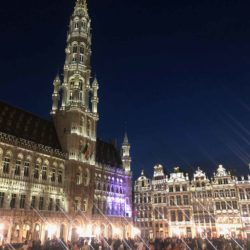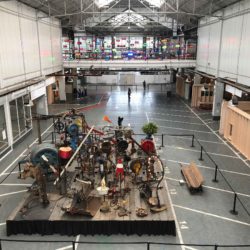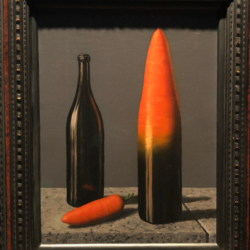
“I’m not a Frenchie. I’m a Belgie!”
This post has run through several iterations in my notebook over the past week, but it wasn’t until I spoke with a friend about the importance (or unimportance) of historical details that a theme began materialize in my mind. An encyclopedia of the composer Stephen Sondheim was recently published and several rabid fans of the master immediately began lamenting the numerous errors that were to be found within. “Sondheim only contributed three songs to this film, not five,” groused one particularly annoyed reader online. The world had come to an end. Or had it?
Of course, one should always strive for historical accuracy, but does understanding the big picture trump any muddling of the details? If I tell you a city has a population of 4.9 million people and it actually is 5.1 million, do you still not understand that it is a large city? If I write that a church was built in 1358, when the cornerstone was actually laid in 1362, do you still not grasp that it is a 14th-Century structure (or even that it is simply an old church!)? If a king really ruled from 1643-58 and not 1652-72, how does this affect your knowledge of history or your enjoyment of travel in any real way?
Relax. I’m not just going to start making up facts and figures willy-nilly. I believe that details are very important; in fact, they can enrich your travel experience, elevating it from the generic to the rare. Let’s look at various examples of religious architecture and urban green spaces in Brussels to prove this point. Announcing to a group of strangers at the hostel communal table that you’re embarking on a sojourn to several churches after breakfast is sure to elicit more than a few eye rolls. “If you’ve seen one church, you’ve seen them all,” is a common refrain of backpackers weary from the road. They are viewed as easy attractions with which a guidebook can pad its “must-see” list; Lonely Planet recommends no less than two dozen churches to put on your to-do list in Brussels alone. How can the tedium not set in?
Let’s turn to Mary Poppins for that answer, “In every job that must be done, there is an element of fun. You find that fun and snap! The job’s a game. And every task you undertake, becomes a piece of cake.” Quite right, Mary Poppins, quite right! Sometimes turning cultural immersion into something of a game makes giving yourself a self-education through travel become easier, and it’s the details that will help you pass the final exam. If understanding the different styles of architecture or landscaping feel daunting to you, and they certainly did for me, that’s ok. Let the details be your guide. Understand the differences between Gothic, Neoclassical and Renaissance aesthetics by leaning into the details and enjoying them, rather than allowing them to bog you down.
Now enough with this preamble; let’s begin!
Église Saint-Jean-Baptiste de Molenbeek/Sint-Jan-de-Doprkerk (Saint John the Baptist Church of Molenbeek)
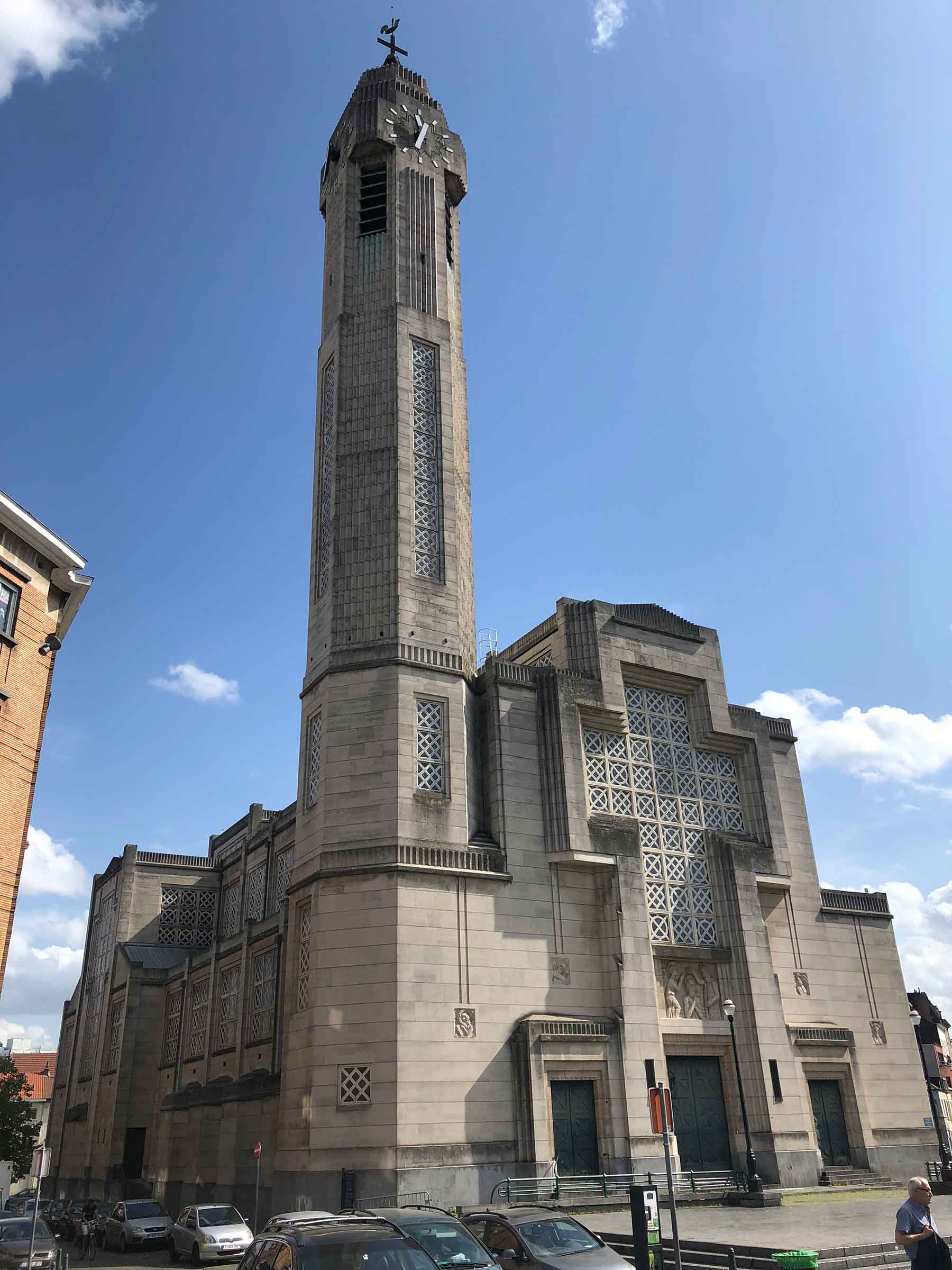
An afternoon of architectural self-study while traveling is a godsend for visual learners. You’re not sitting in a classroom, listening to some dry professor drone about the differences between Art Nouveau and Art Deco. You’re out in the world seeing the differences. Speaking of Art Deco, our first stop is at Saint John the Baptist Church in Molenbeek, a western district of the capital.
Art Deco originated at a 1925 Paris Expo for art and design. The style emphasized the luxury and glamour of the 1920s through strong geometric patterns, with nods to the new technologies that had developed in the first decades of the 20th Century. The Chrysler Building in New York is a prime example of Art Deco architecture, but how does this decadent style harmonize with religious architecture? It turns out, quite well! The Belgian architect Joseph Diongre built Saint John the Baptist Church between 1931-32 using reinforced concrete rather than stone, the first of its kind in Brussels. Molenbeek has traditionally been an industrial, working class neighborhood and Diongre wanted to pay tribute to the locals by employing a material that matched their personality.
Diongre’s design realigned the lone 56m (184ft) tower, which would normally center either the front or rear of the church, to a left-of-center position when looking at the building. The Art Deco influence is nowhere more apparent than in the geometric stained-glass window on the front of the church. The building is stylish and chic, and yet still embodies the aesthetic of the working-class neighborhood.
Cathédrale des Saints Michel et Gudule/Kathedraal van Sint-Michiel en Sint-Goedele (St. Michael and St. Gudula Cathedral)
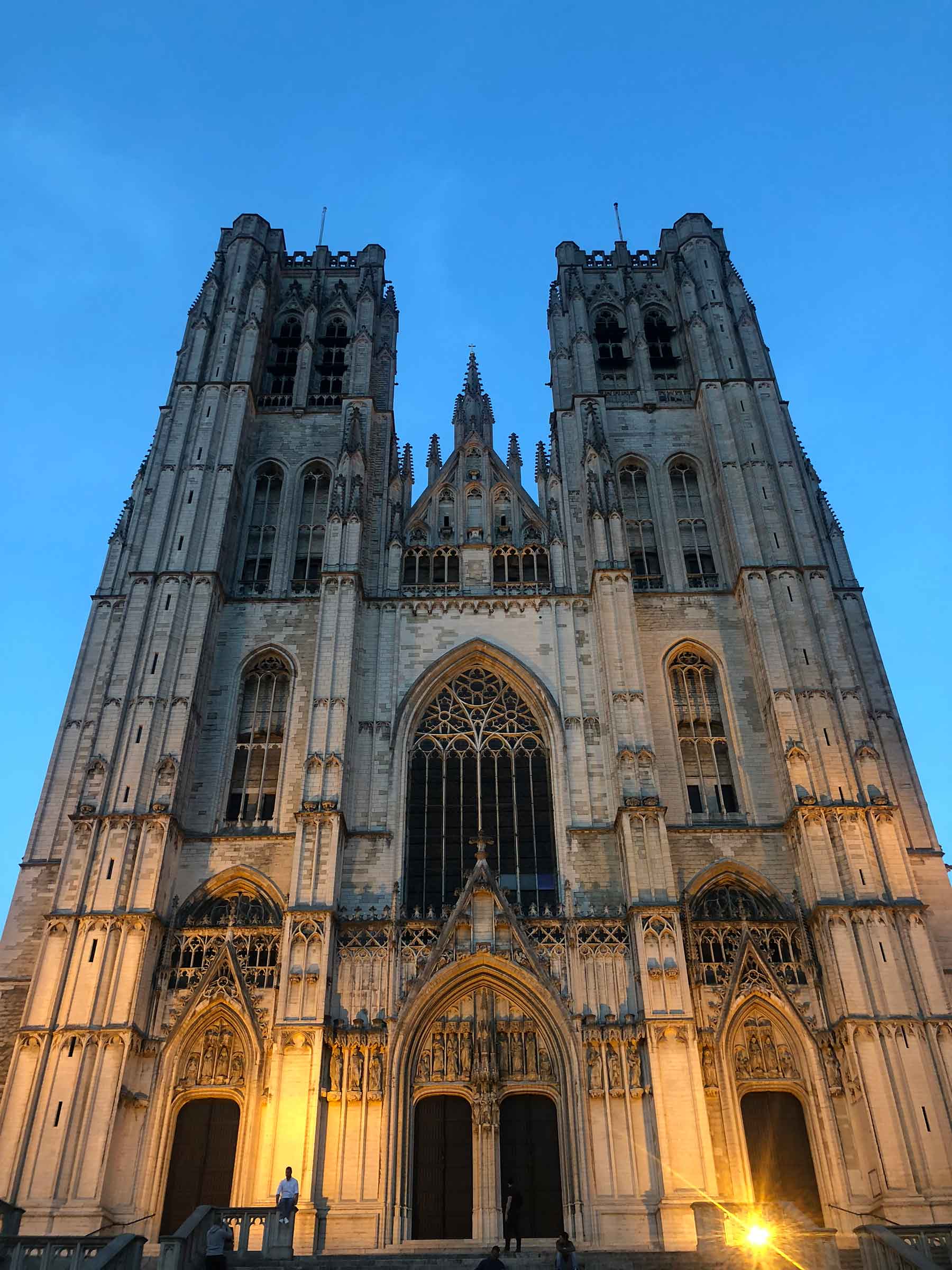
One skill I’ve had to develop while traveling is learning to how to sift through the details to find out which ones are important to me. When I embarked on my first great backpacking adventure in 2001, I relied heavily on my guidebooks, not only to know which sights to visit, but also to act as a reference for what I should pay attention to at each attraction, rather than allow myself to explore the point of interest organically. For example, read this passage from Rough Guides’ Belgium & Luxembourg:
[Referring to a stained-glass window] Look closely and you’ll spy the donor in the lower foreground with an angel on one side and a woman with long blonde hair (symbolizing Faith) on the other. Each of the main colors has a symbolic meaning, green representing hope, yellow eternal glory and light blue heaven. There’s more interesting work in the transepts- in the north transept Charles V kneels alongside his wife beneath a vast triumphal arch as their patron saints present them to God the Father, and in the south transept Charles V’s sister, Marie, and her husband, King Louis of Hungary, play out a similar scenario.
Yikes. And it goes on from there. Maybe if you’re an intense history buff, this will be of interest to you, but even then, it’s awfully esoteric. It’s the kind of information a long-winded audio guide heaps over you, going in one ear and out the other. There are a lot of details, but they’re not coming together to form a bigger picture. What are you, as a traveler, supposed to take away from that information?
Personally, I would rather learn details that can be translated to my better understanding of a subject. This cathedral, known as Belgium’s National Church, was built in the Brabantine Gothic Style, which is the division of Gothic architecture found in the Low Countries as opposed to “standard” Gothic architecture in France. One big difference between the two is that French Gothic churches commonly have rose-shaped stained-glass windows above the main portal, while Brabantine Gothic architects preferred a pointed arch. This is why you will find very few rose stained-glass windows in the Benelux countries.
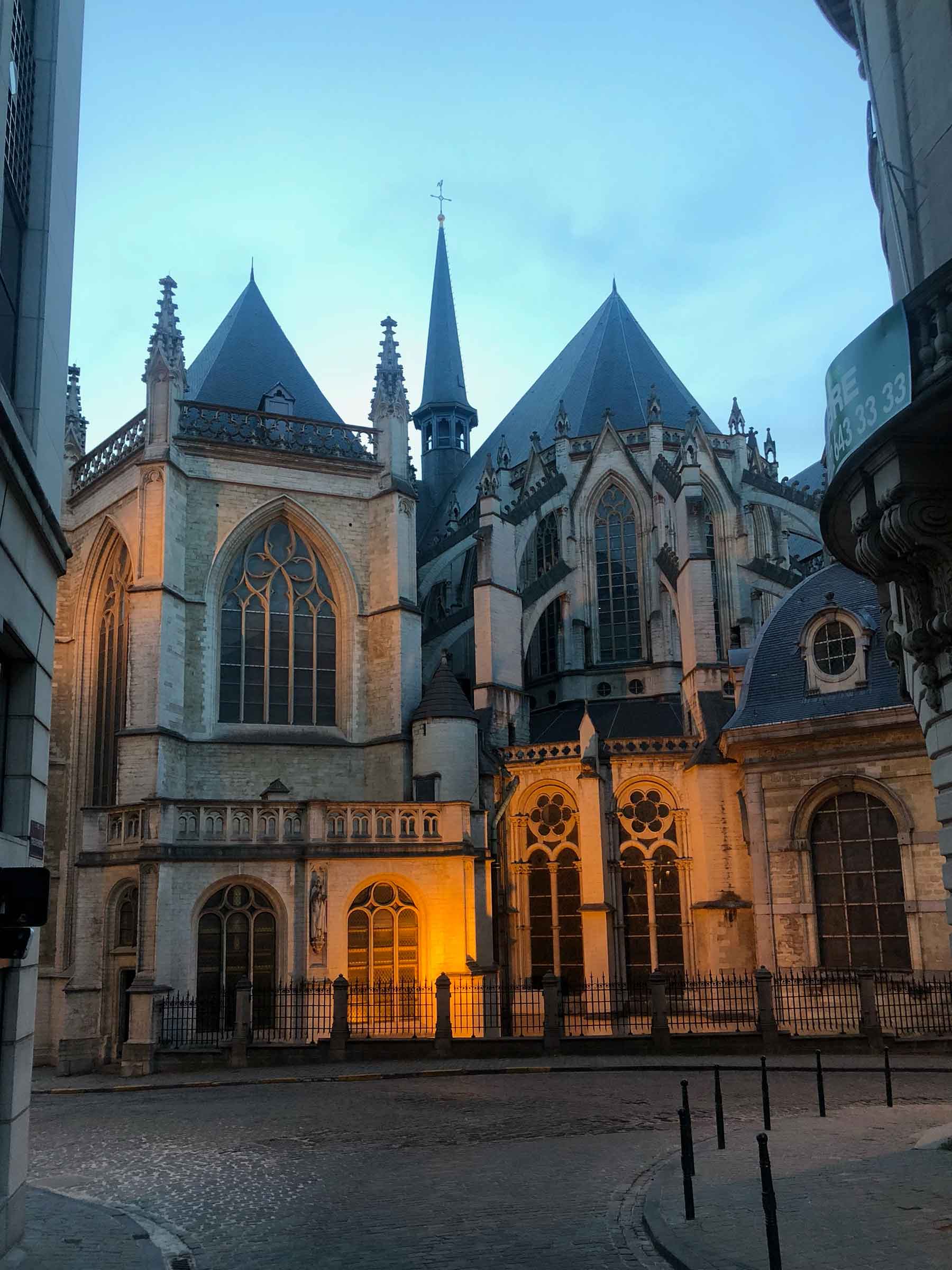
Ground was broken in 1226 for St. Michael and St. Gudula’s, but construction wasn’t completed until 1519, nearly 300 years later. Naturally, the cathedral’s design passed through several different architects, all inspired during different periods within Brabantine Gothic’s popularity. If you start walking from the rear of the cathedral to the front, you can witness the evolution of the building from Early Brabantine Gothic to High Brabantine Gothic.
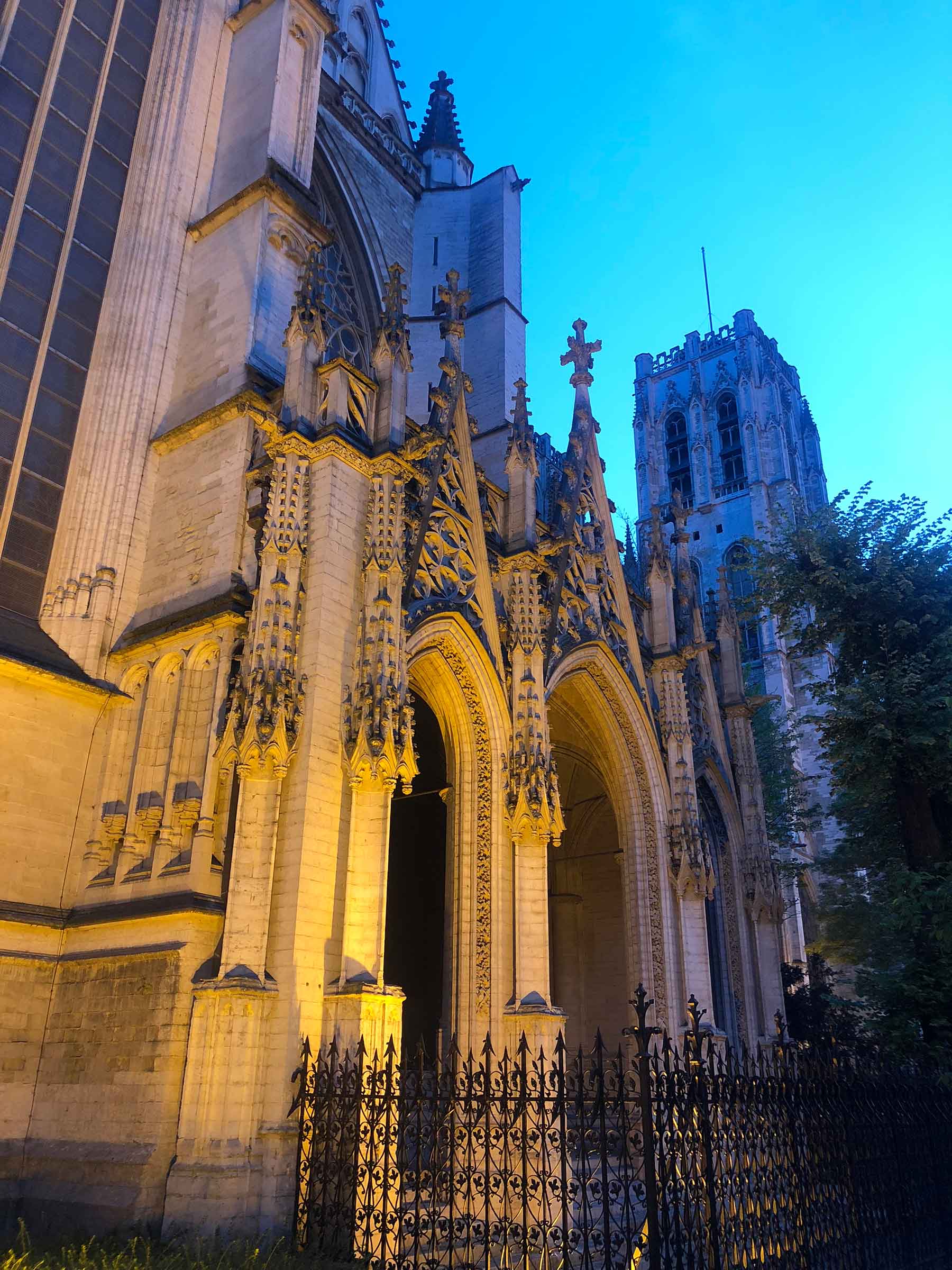
The entryways were the final pieces to be installed on the cathedral and are the most ornate. Also, while many French Gothic Cathedrals, like Notre-Dame de Paris, were largely constructed from limestone, the Brabantine varieties were often erected using sandstone; extensive erosion has plagued these Belgian cathedrals in the centuries since, and the frequently-required restoration comes with a hefty price tag.
Mont des Arts/Kuntsberg
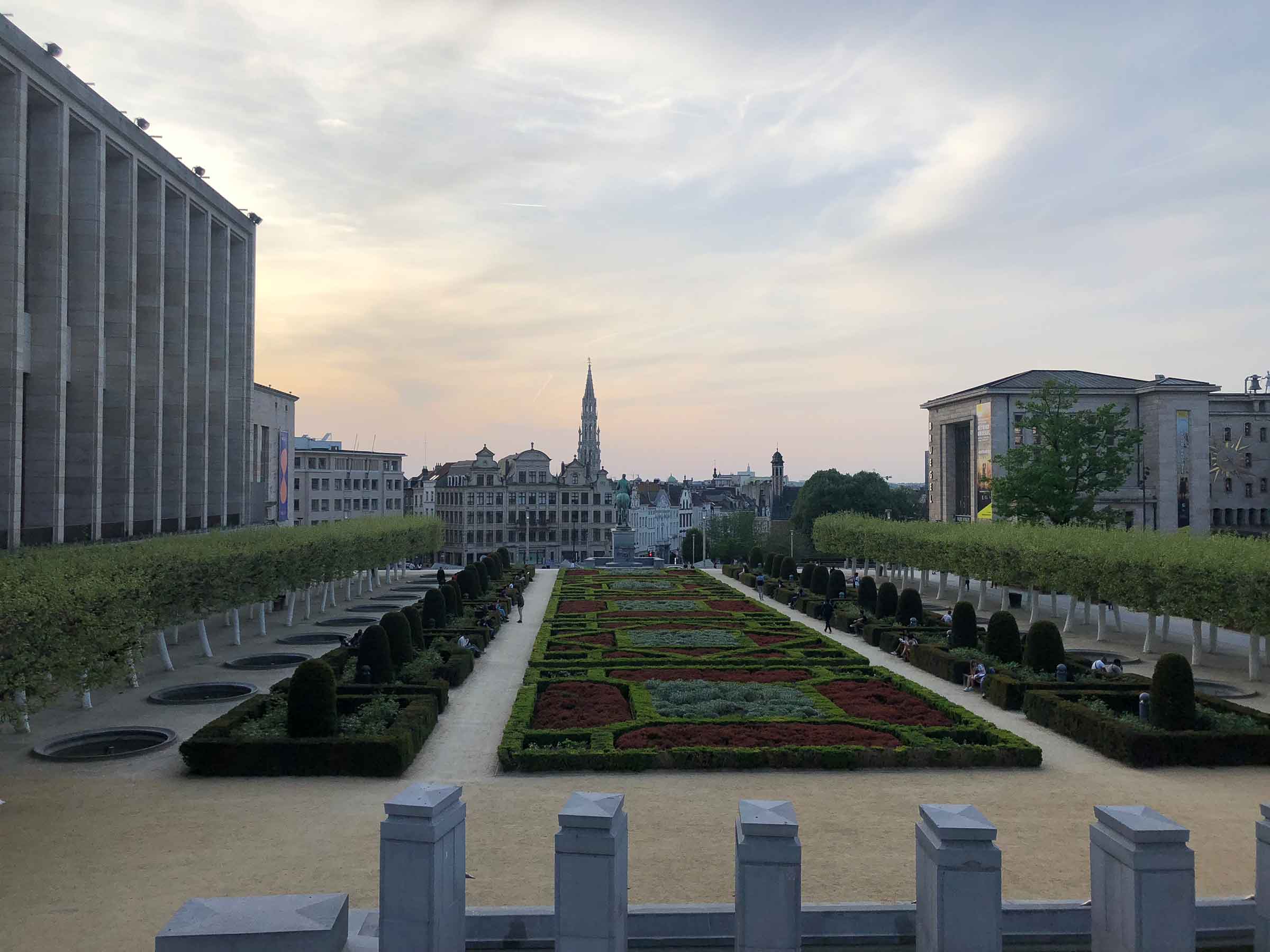
In the late 19th Century, King Leopold II wanted to build a grandiose complex that would house ten museums showcasing different aspects of the arts. This so-called Mont des Arts would overlook the Grand Place and Lower Town from the edge of the Upper Town. The mayor of Brussels at the time agreed, but wanted to preserve as much of the old neighborhood around the proposed buildings as possible. Leopold desired complete demolition of two historic districts and the city council sided with the King (shocker!). By 1900 the area had been leveled, but the council regrettably had to inform the King that the city was broke and could not complete his project. (Once again, we all saw that coming.)
Leopold decided to install a temporary garden along the vista until the appropriate funds could be raised, but he never lived to see his dream realized. The garden proved very popular with the locals and when several buildings, including the National Library and Palais des Congrès, were finally constructed in a modernist style during the 1950s, the garden was reconfigured into a French Formal Garden that leads to a cascading staircase overlooking the Lower Town.
Several aspects of French Formal Gardens are instantly recognizable at Mont des Arts. There is an emphasis on well-maintained geometric shapes and perfect symmetry between the two sides of the garden. The plants are meticulously trimmed, demonstrating man’s power over nature. There is a terrace built into the staircase so that viewers can soak in the big picture and admire the precision with which the garden is cared for. There is nothing wild, overgrown or romantic about French Formal Gardens. They are a model of restraint.
L’obélisque et fontaine Anspach/Obelisk-Fontijn Anspach (Anspach Obelisk and Fountain)
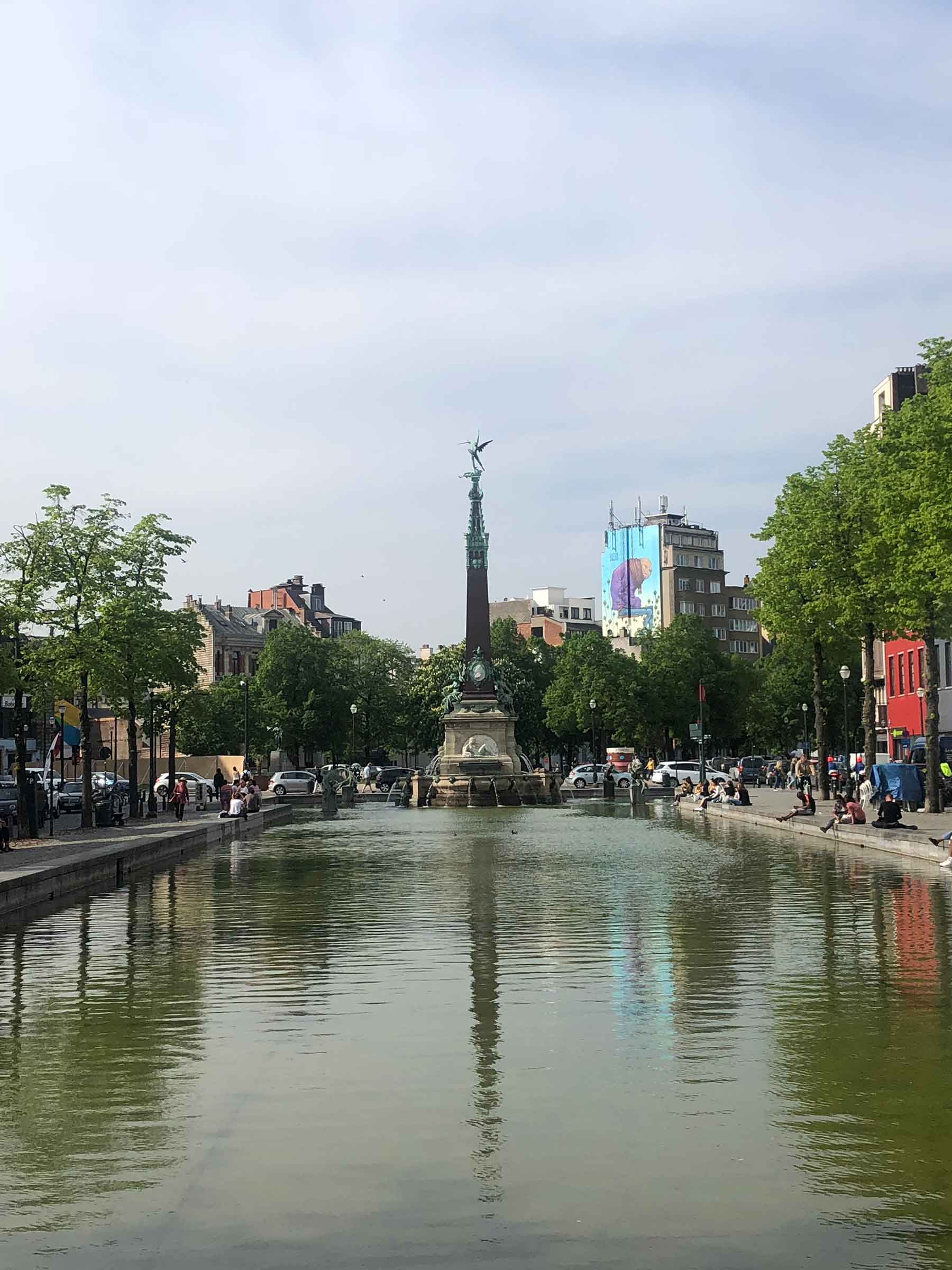
Quick: name the architectural style of the obelisk pictured above. If you’re scratching your head because it looks like a mash-up of too many different styles, you’re on the right track. The Anspach Obelisk and Fountain is a prime example of Eclecticism, the combination of several old styles to create something new. Eclecticism was popular in Belgium roughly between 1860-1920 and became a competing school of thought with the Revivalists, who wanted to bring back older styles, but in a more faithful manner. Eclecticism prescribes taking a pinch of this and dash of that, but the end result is something completely new and creative. Revivalism is rooted in nostalgia for a past era (e.g. Gothic Revival would be a modern building constructed slavishly in the Gothic style).
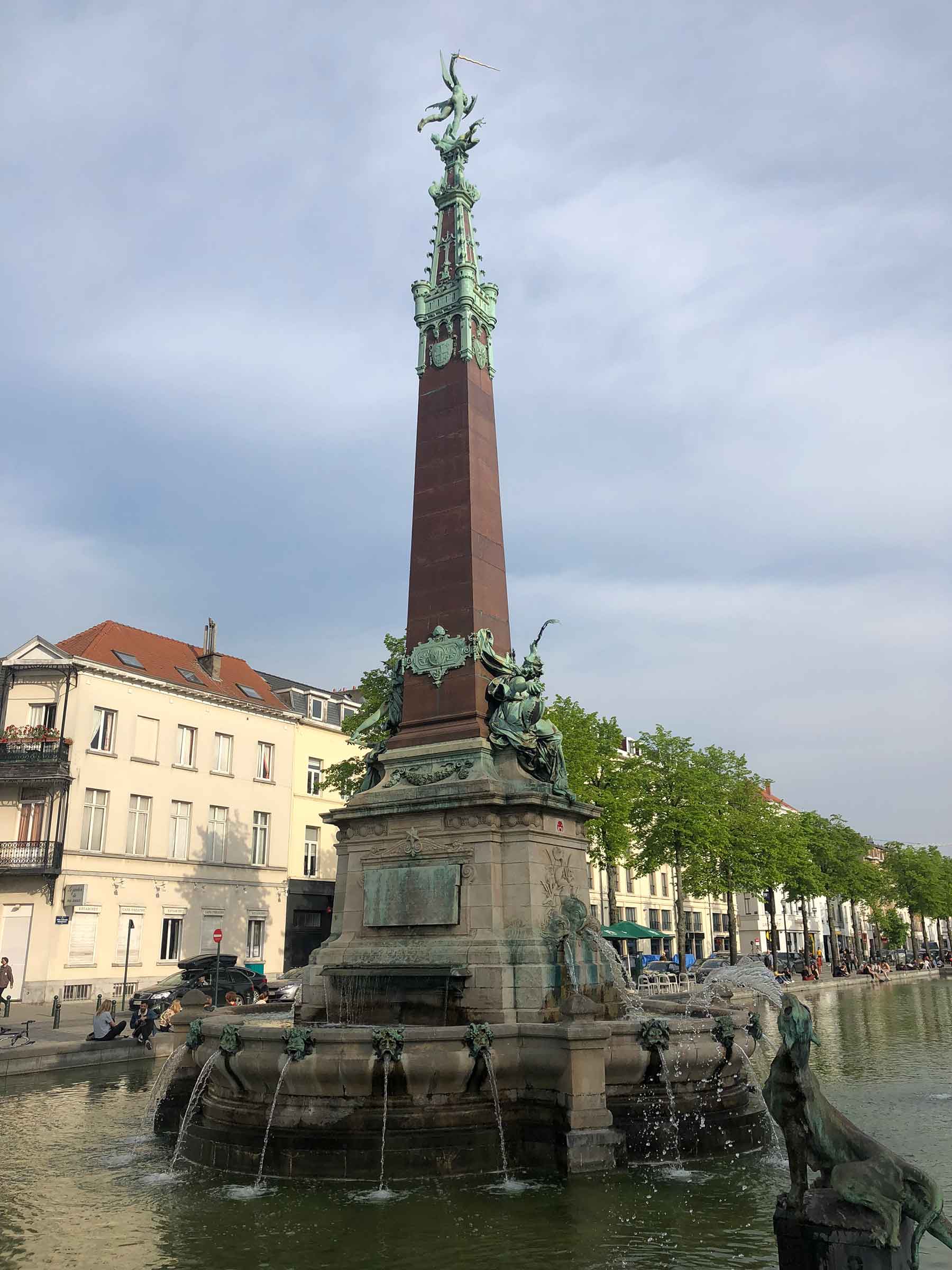
The obelisk was commissioned by Leopold II as a tribute to the River Senne, which flows through Brussels. It was originally unveiled in 1897, but had to be moved to its current location at the former Marché aux Poissons (Fish Market) in 1981 due to an expansion of the metro. This is a rather trendy area of town and the pond is lined with chic cafes and brasseries. While I’m sure the food at Gaston’s is perfectly fine, this is a place to see and be seen.
Église Saints-Jean-et-Étienne-aux-Minimes (St. John and St. Stephen’s Church)
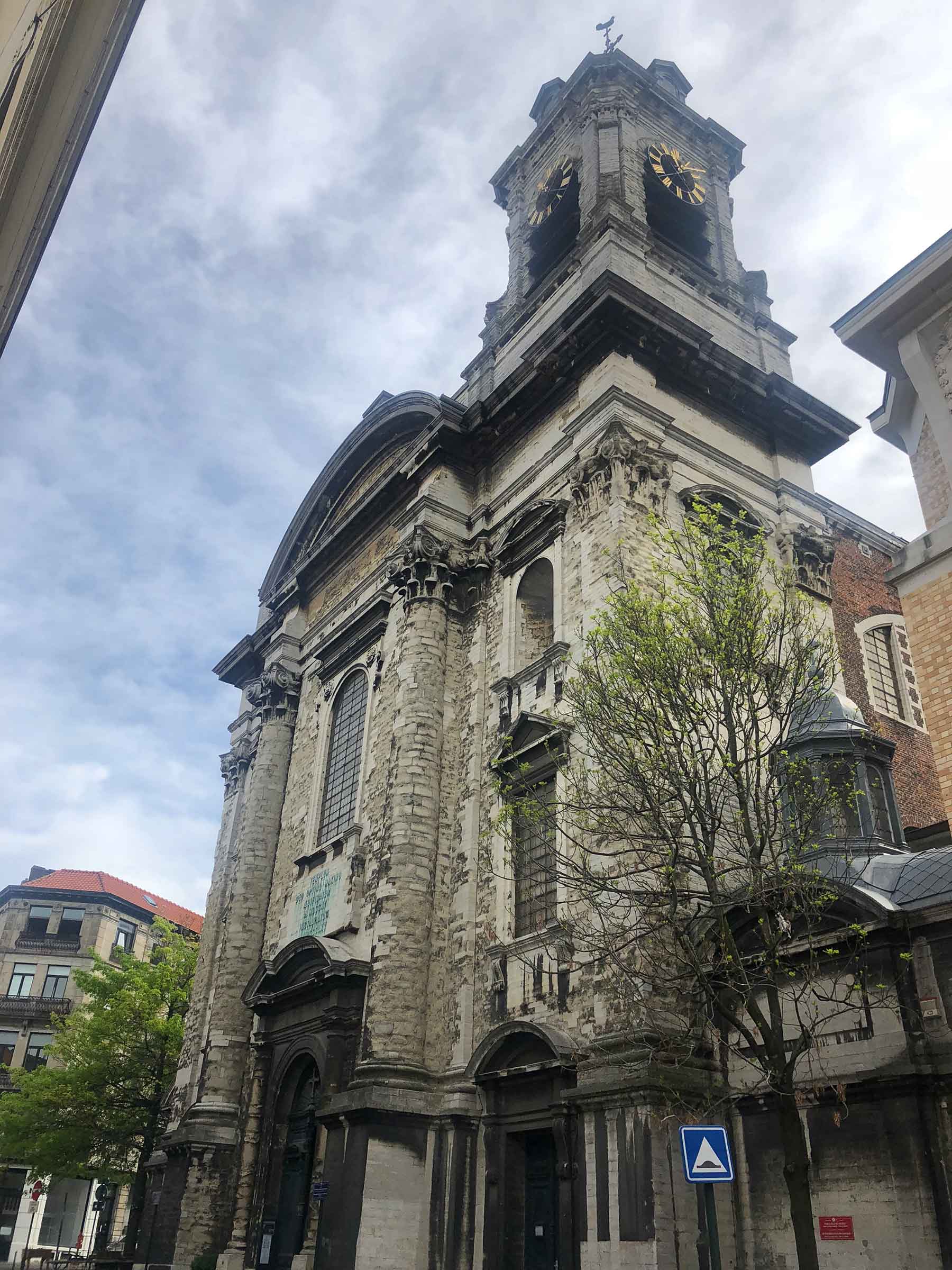
Next up, we have the Baroque St. John and Stephen’s Church, which used to be part of a larger monastery that has since been sold and knocked down. The church was built in the late-18th Century, which is nearing the end Baroque period that was kickstarted in response to the Protestant Reformation in 1517. As Protestants began defecting from the Catholic Church, rather than alter their ways, the Catholics decided to entice its congregations to remain in the fold by building churches full of drama and grandeur. “You’re free to go join Martin Luther, but before you do, just know that those Protestant churches are small, plain and ugly. Stick with us and we’ll put on a show with lots of panache and pizzazz!” This Counter-Reformation strove to be as ornate and ostentatious as possible.
Parc de Bruxelles/Warandepark (Brussels Park)
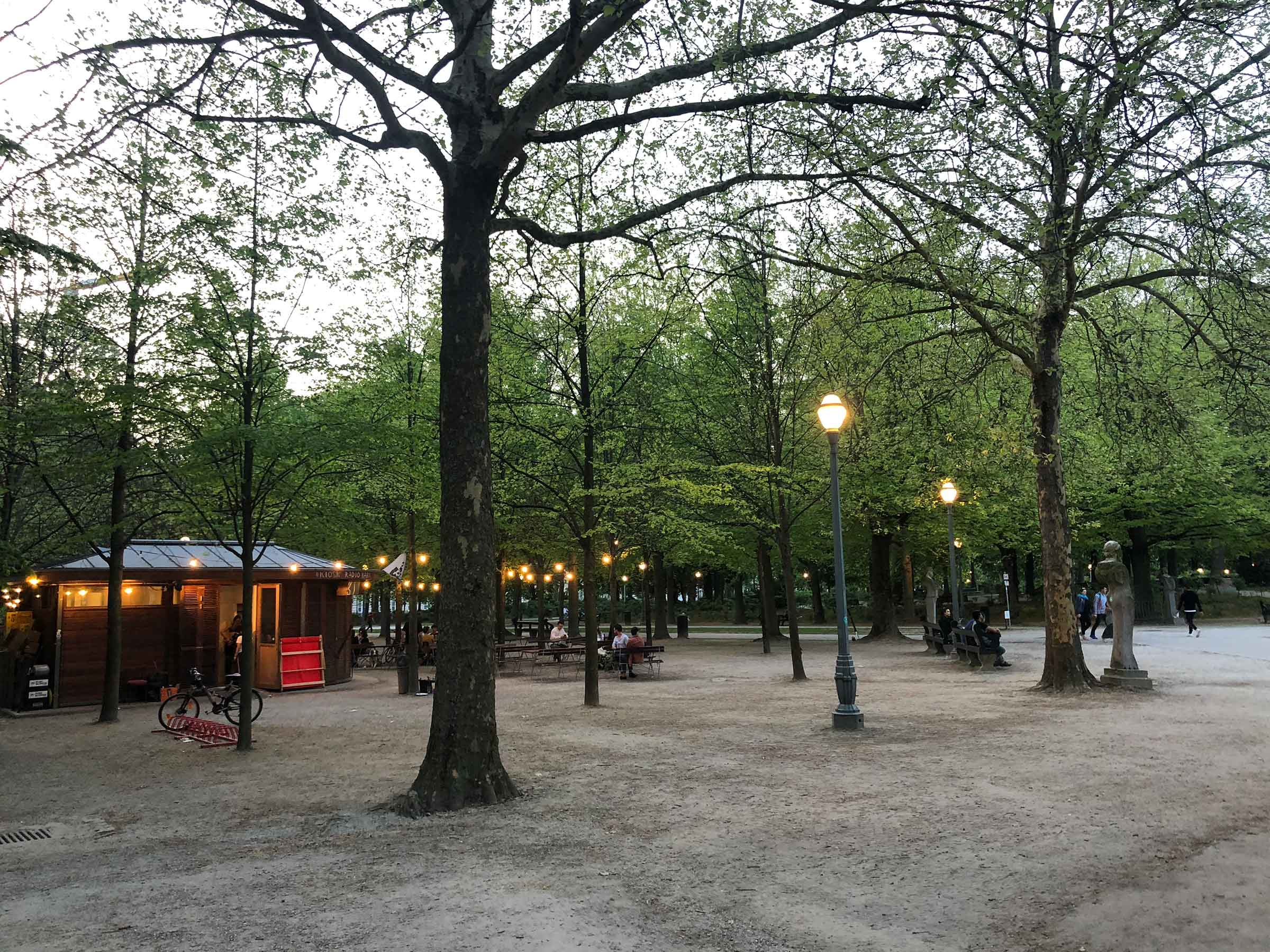
Brussels Park is the largest urban green space in the capital. Several metro lines intersect under the park; the park is flanked by the Royal Palace to the south and the Palace of the Nation to the north, making this is a highly-trafficked area of the Upper Town. The park was built between 1776-83 in the Neoclassical style. Following the Classical urban planning guidelines of Ancient Rome, the park is laid out in a grid network with the occasional diagonal pathway inserted into the grid. Everything centers around the octagonal pond in the center and radiates out from there. Art Deco lamps were added to the park in the 1930s, which I suppose makes this now an example of Eclecticism!
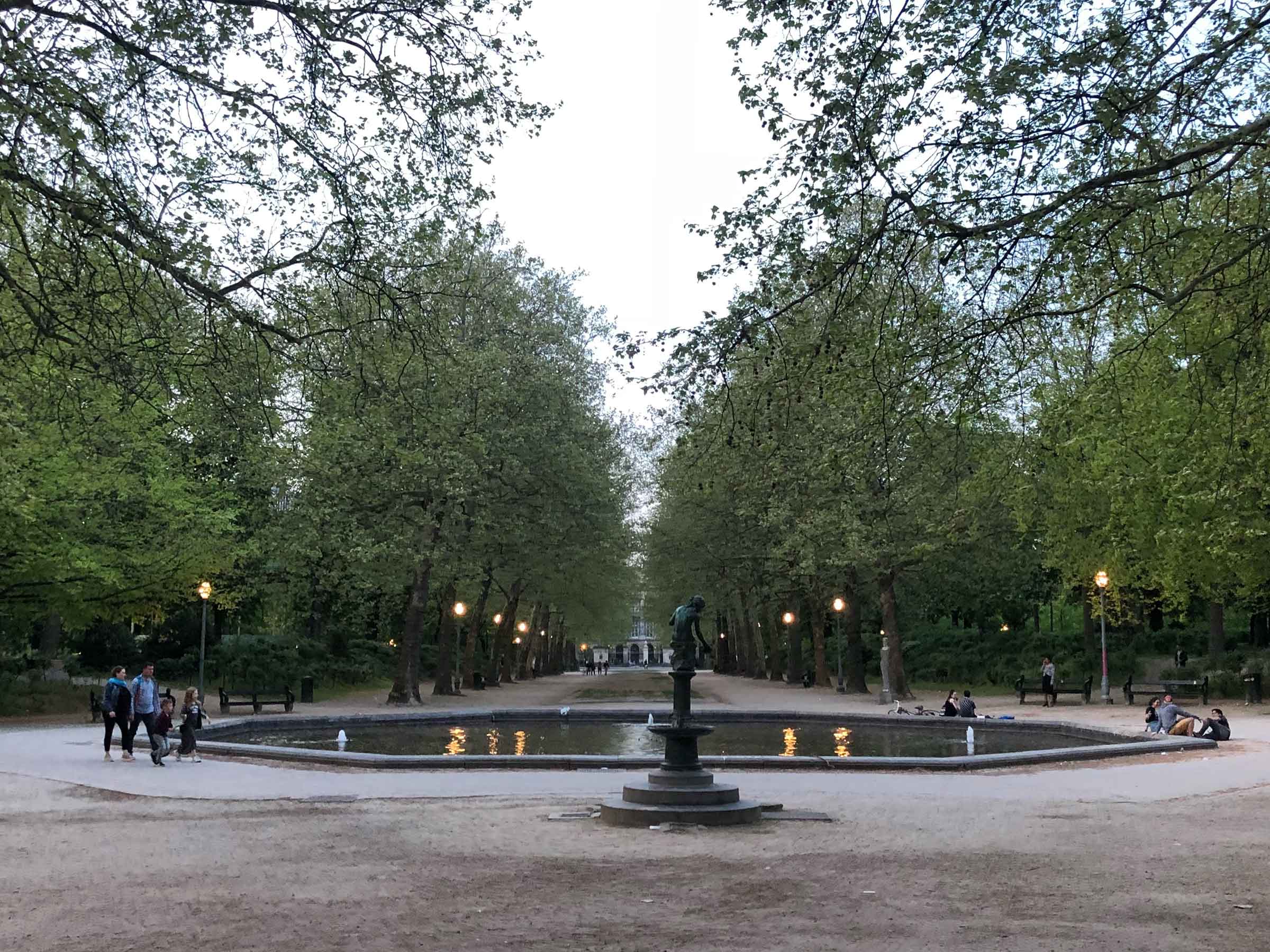
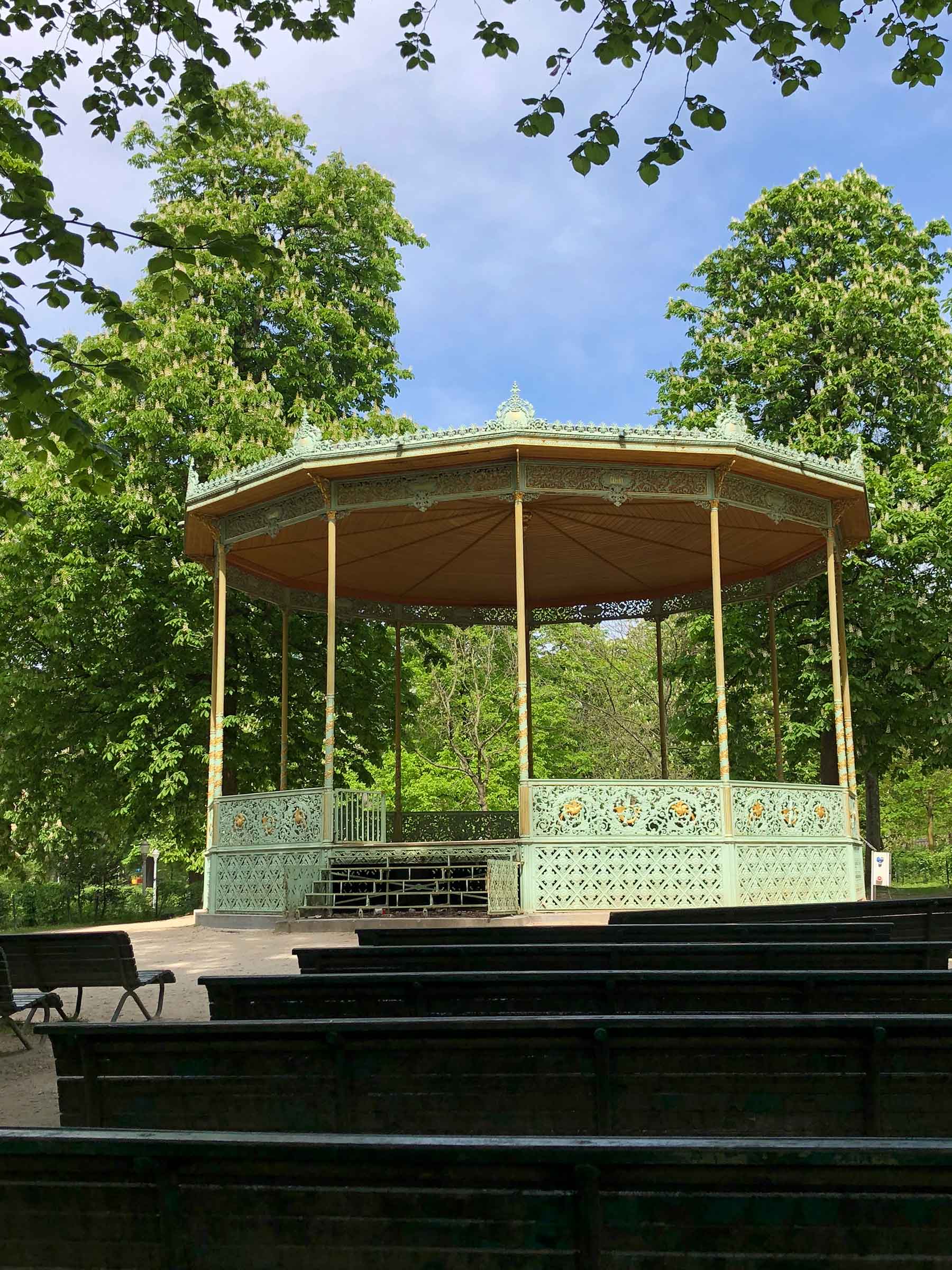
Around lunchtime, the park fills up with government workers, scarfing down a sandwich while they furiously answer emails and shoot off texts. Here I am, snapping photos and feeling like I’m in a dreamland, and everyone else is buried in their phones. Of course, back in New York this could totally be me. Travel not only allows you to visit new places, but it gives you the chance to reevaluate how you interact with your “hometown” surroundings. It’s easy to take what has always been there for granted, but if this past year of the pandemic has proven anything, nothing is guaranteed to stick around forever and you never know when your favorite restaurant or museum will be gone forever. Treasure and value things while you can, as they could be taken from you without warning.
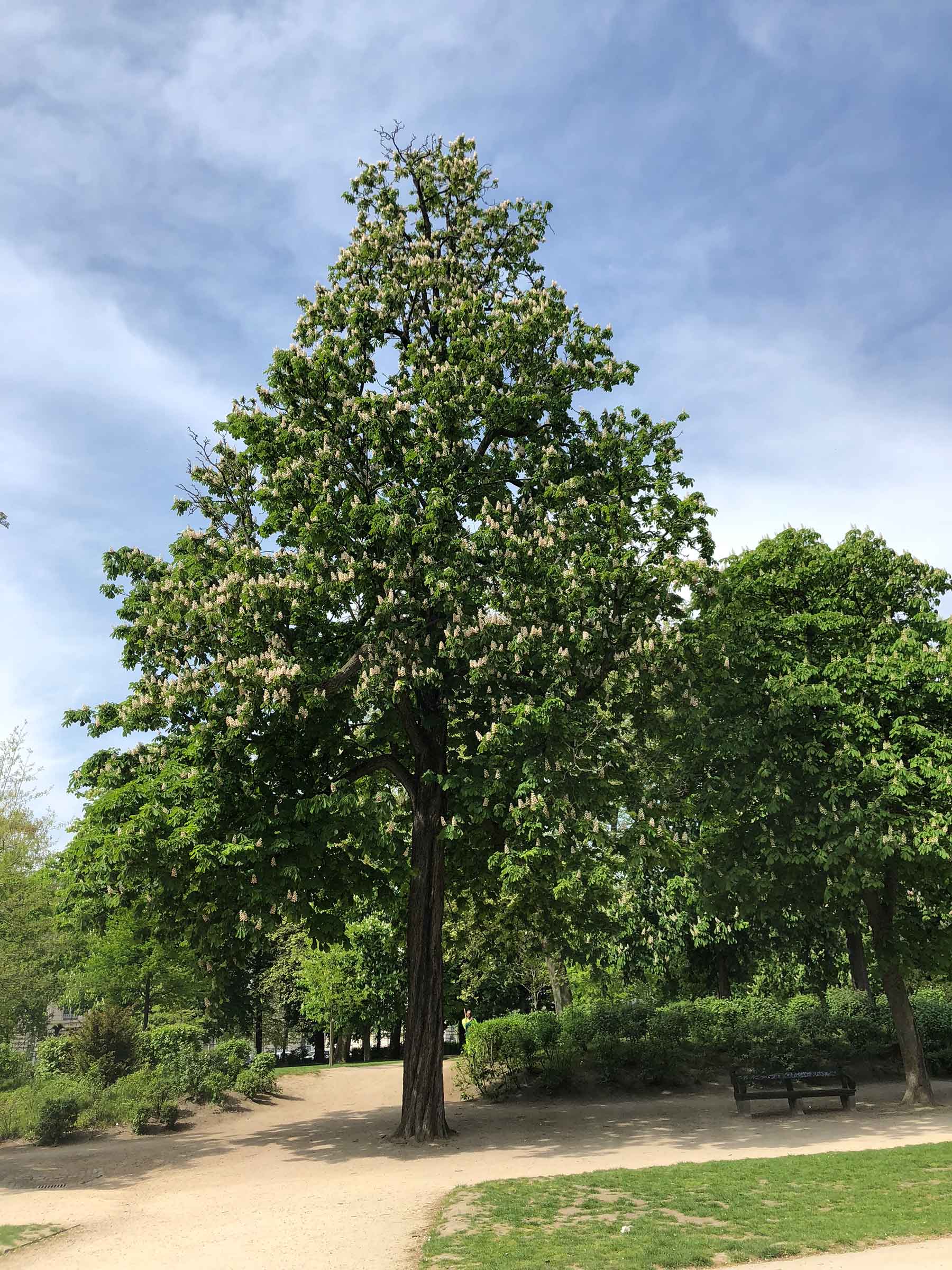
Brussels Park initially was used as a garden and hunting ground for the royal family. Nine of the original trees planted in the garden are still alive today and have been granted special “monument” status by the government. The park is vibrant and green in the daytime before transforming into a charming and romantic spot in the evening. The Neoclassical grid lines are orderly, but the trees and bushes themselves are left to grow are they please. This is in sharp contrast to the French Formal Garden of the Mont des Arts seen earlier.
Palais de Justice/Justitiepaleis van Brussel (Law Courts of Brussels)
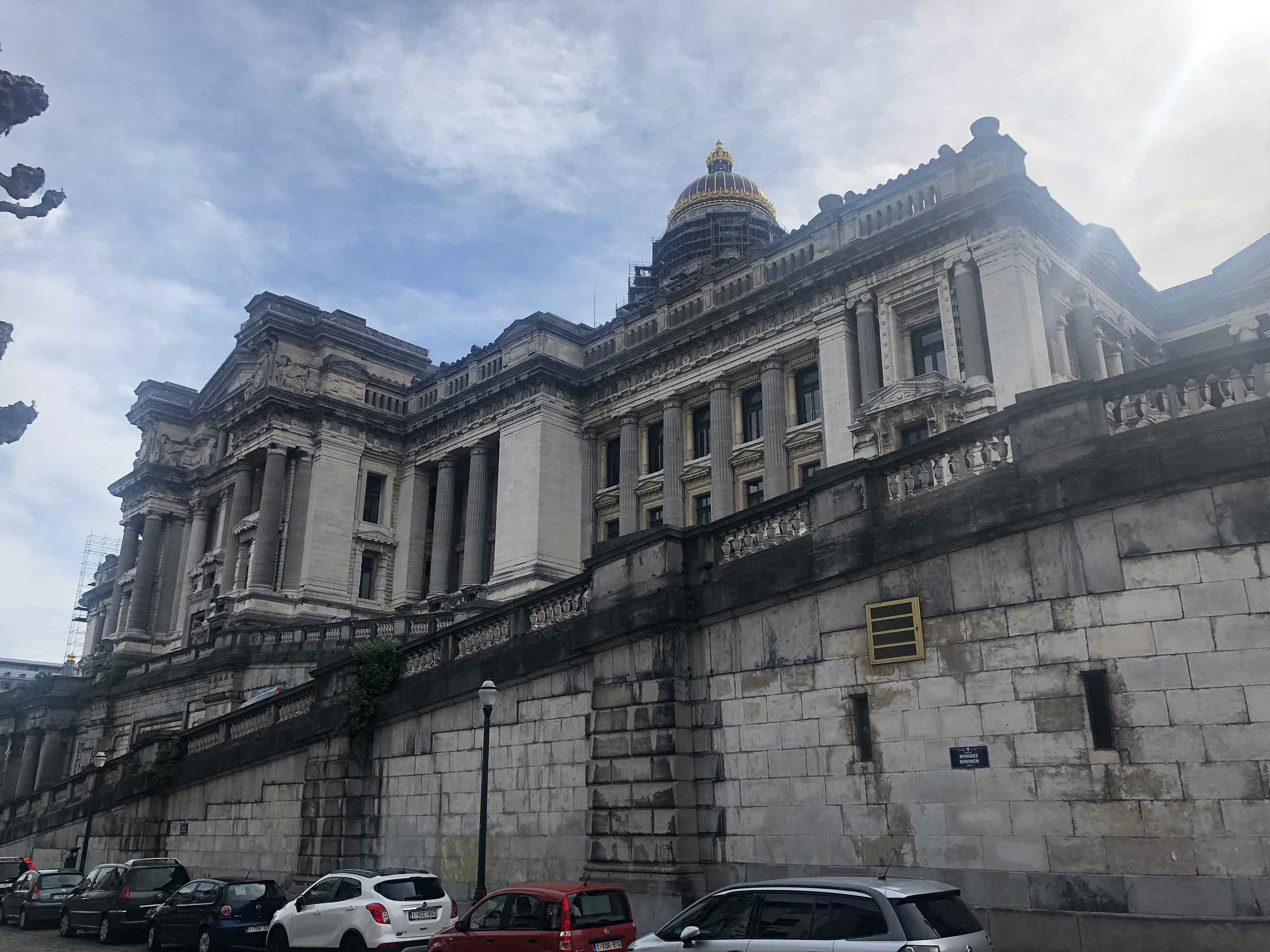
No matter how I attempted to frame the Law Courts in photos, I never was able to fully capture the scope of the entire building, which encompasses several city blocks. Constructed between 1866-83, the building has earned the distinction of being the largest erected in the 19th Century. Joseph Poelaert was a disciple of Eclecticism and incorporated elements of Greco-Roman, Baroque and Neoclassicism architecture into his designs. The monstrous courthouse has consistently been voted the most-hated building in Brussels by locals, going back to its inception.
Similar to Leopold II displacing residents to build the Mont des Arts, Poelaert demolished over 1000 homes to clear enough land to build his palace of the law. (Each household was given a stipend and a room in a far-flung suburb in an attempt to mollify the pain, but it only served to further incense the residents.) Poelaert earned the nickname “schieven architect” in the local Brussels dialect, which roughly translates to crooked or shameful architect. The sobriquet morphed into an all-purpose insult which can still be heard today.
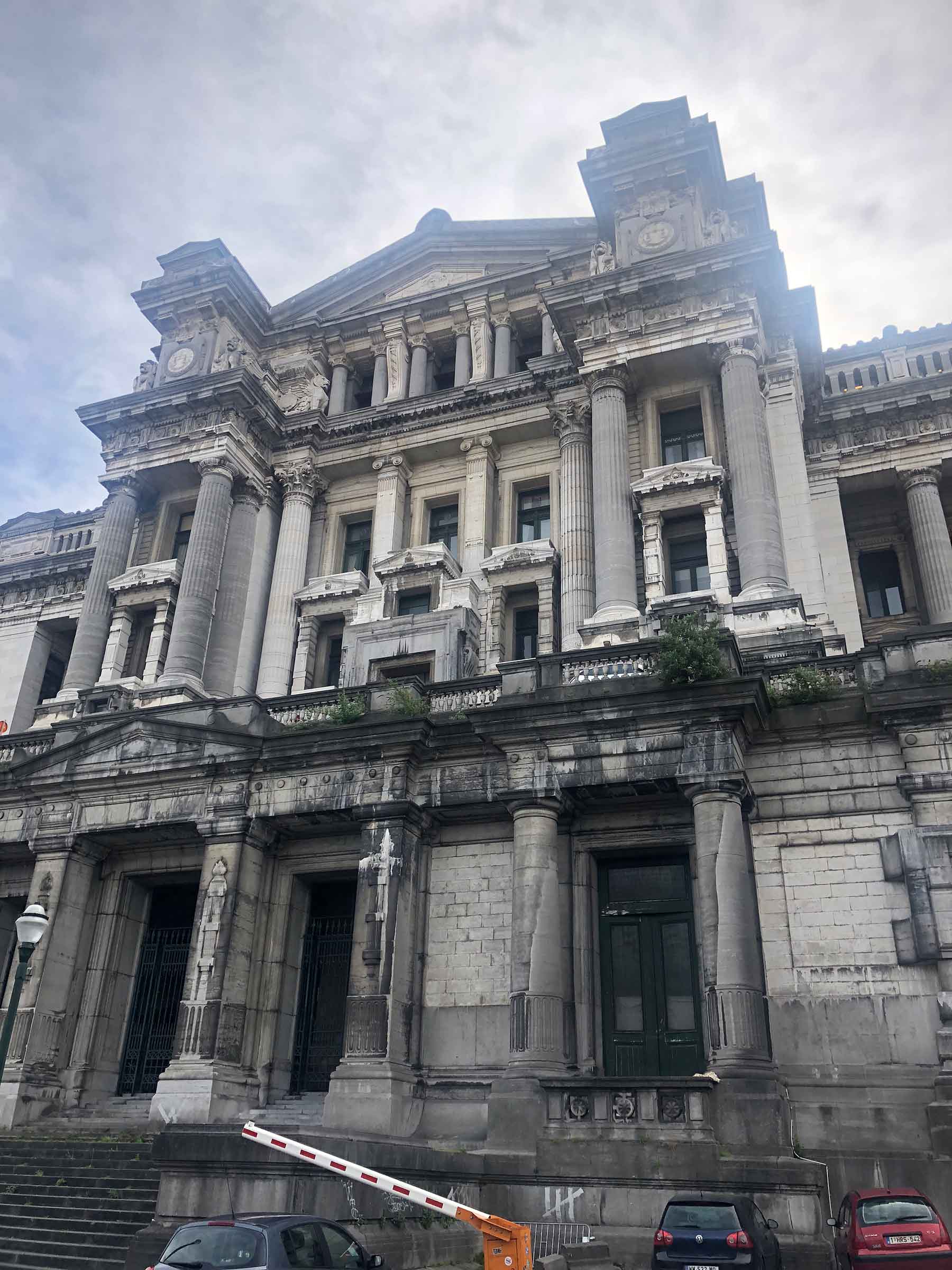
During the German occupation of Belgium in World War II, the Nazis used the courthouse to store all of their Holocaust records. Upon their retreat, the Nazis set fire to the building, hoping to destroy the documents in the process. The only thing that succeeded in happening was the cupola collapsing, which has been encased in scaffolding and never-ending restoration projects ever since. The scaffolding itself has become so rusted and riddled with decay that it must be rebuilt before anymore work on the cupola can be completed. Maybe the Belgians would question my taste level, but I was rather in awe of the building, scaffolding and all. It’s rare to see any structure built on such a large scale and with so many different elements thrown together. Whereas the Anspach Obelisk felt like it came together as a cohesive piece of Eclecticism, I will admit that the Law Courts definitely fall short in that regard.
Monument aux victimes foraines des guerres mondiales (Monument to the Fairground Victims of the World Wars)
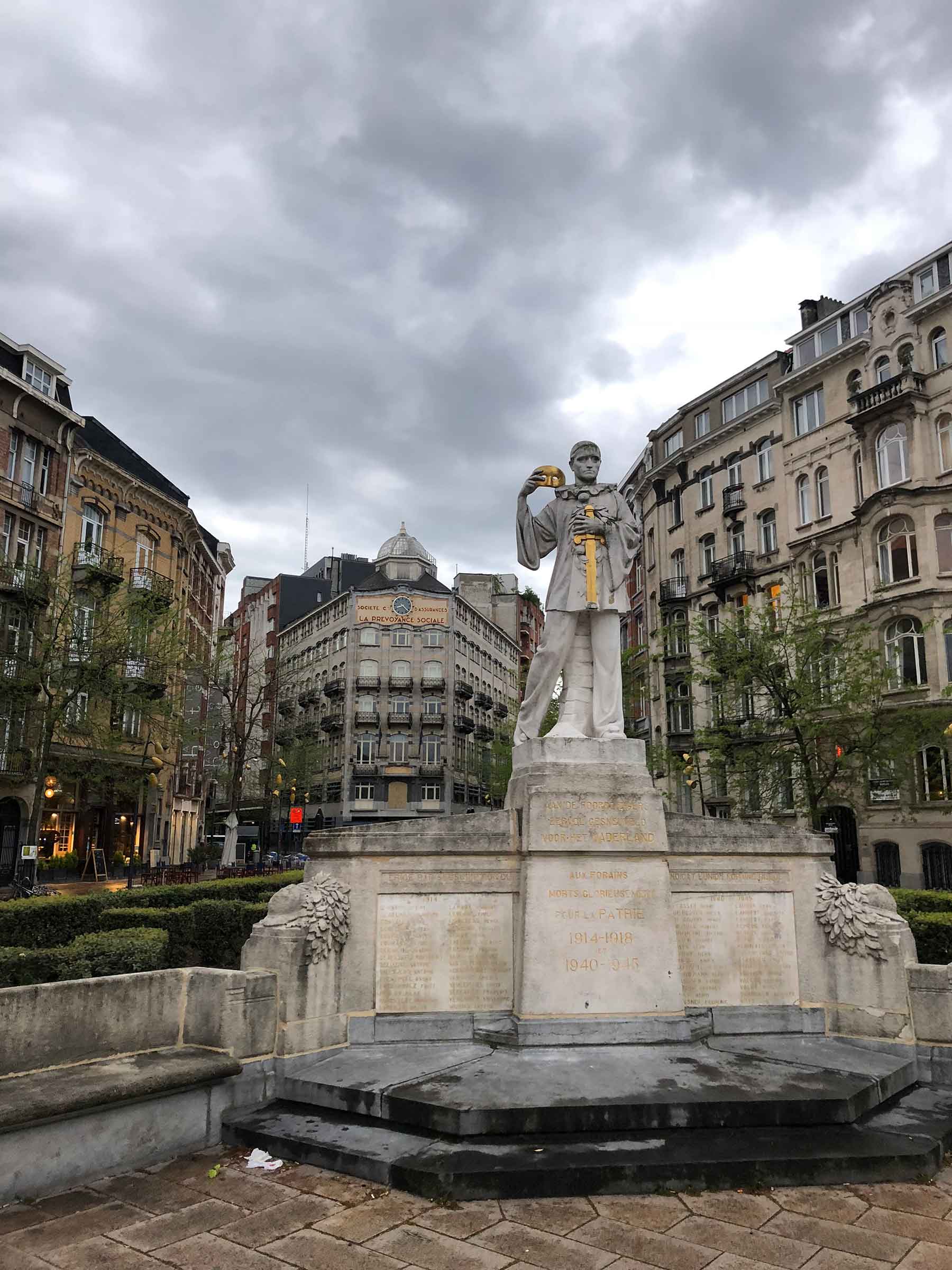
Victor Voets was a Belgian sculptor who worked in the Art Deco aesthetic. He created the above statue in 1924, after World War I, before modifying it after the Second World War as well. In keeping with the Art Deco tradition, this war memorial doesn’t feature brave soldiers or stoic countrymen and women ready to defend the Fatherland. Instead we see Pierrot, a stock character of French pantomime, often described as the sad clown.
During the World Wars, the Belgian military was housed at a large fairground outside of Brussels. Actors and performers who normally worked the fairs remained to entertain the soldiers; the troupes raised the morale of the troops as it were. During both wars, the fairgrounds were bombed and dozens of these actors lost their lives.
Voets also drew inspiration from Leoncavallo’s hit opera Pagliacci, which had debuted in Italy a few decades earlier. In the opera, Canio is the jealous husband of Nedda, who is having an affair with another man. Canio plays Pagliaccio (Pierrot) in a touring commedia dell’arte troupe and upon discovering his wife’s betrayal, kills Nedda and her lover before dropping his mask and exclaiming, “La commedia è finita!!” (The comedy is finished!!). As in the opera, the same fate awaited the the actors who stayed to provide one last laugh.
Synagogue de Bruxelles/Grote Synagoge van Brussel (Great Synagogue of of Europe)
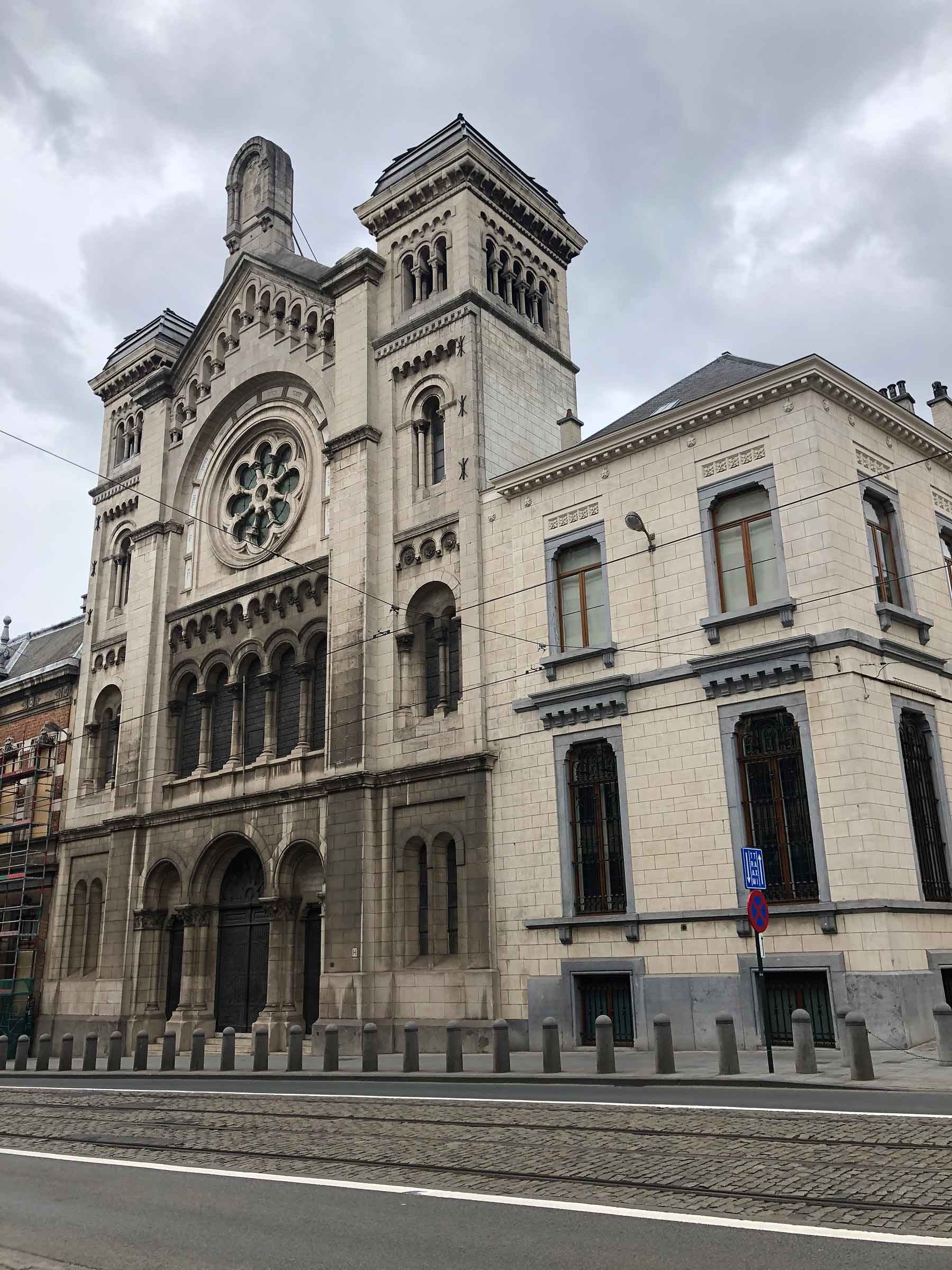
Built in 1875, the Great Synagogue was designed in the Romanesque-Byzantine Revival style. You can see the semi-circular arches that differ from pointed arches of the various Gothic styles. The revival incorporated the sturdy pillars and boxy, twin towers associated with Romanesque architecture. Ornamentation is spare; simplicity was preferred over the intricacies found in Gothic churches. Due to the hefty nature of these aesthetics, many of the castles, churches and synagogues have stood the test of time.
Miraculously, the Synagogue was not damaged during the German occupation, but in 1982, the house of worship was the site of a terrorist attack where a man armed with a machine gun opened fire on the congregation. Since then, it is possible to go inside, but you must make an appointment ahead of time, something I wasn’t aware of when I visited the city. By all accounts, the interior is stunning and worth making the effort to see.
Musée juif de Belgique/Joods Museum van België (Jewish Museum of Belgium)
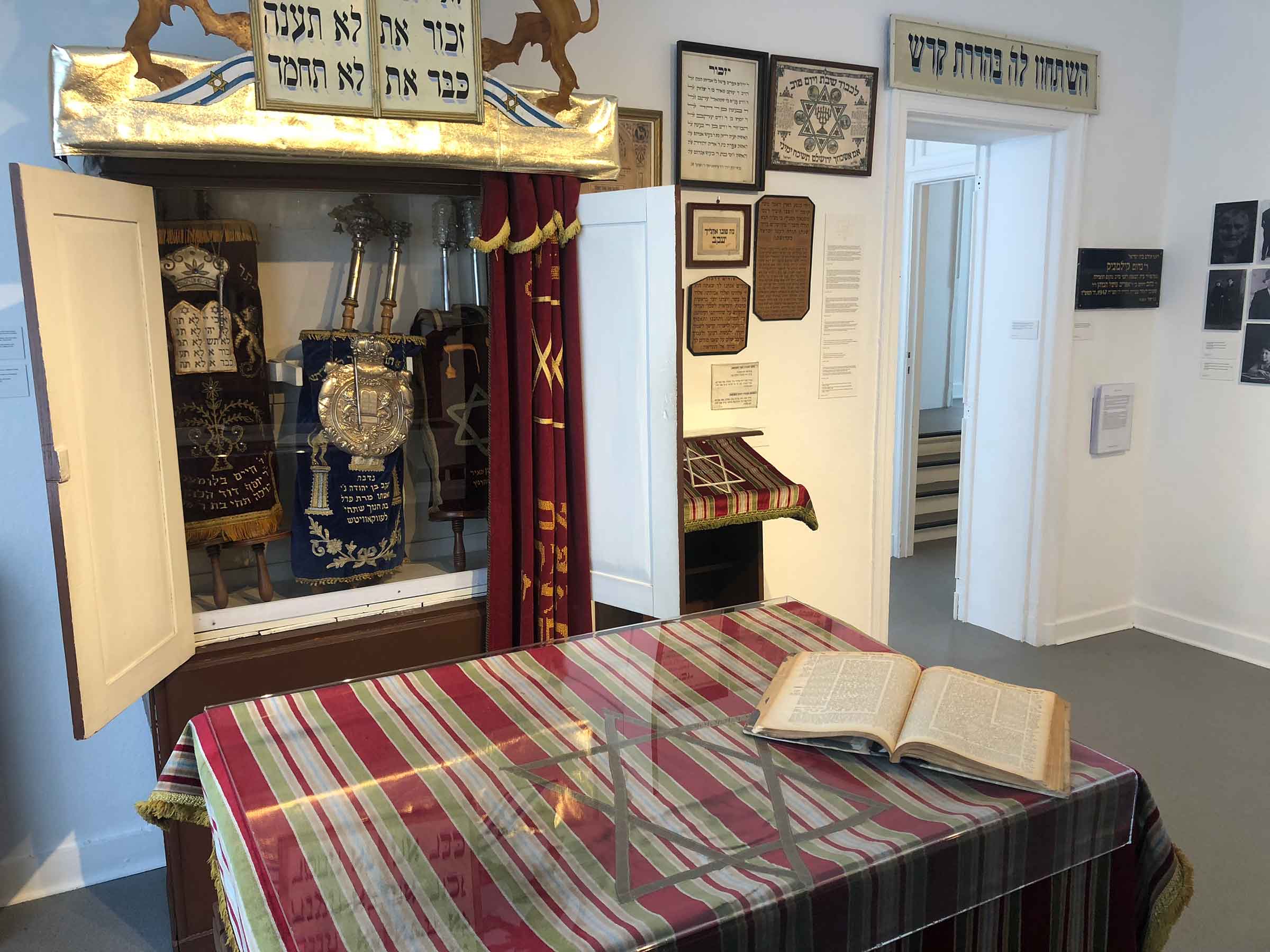
Taking a slight pause from our architectural pursuits, if you haven’t made arrangements to visit the synagogue (or even if you have), it’s absolutely worth your time to stop in at the Jewish Museum of Belgium. Despite Brussels having the fourth largest Jewish population in Europe (20,000 Jews currently call the capital home), a museum celebrating Jewish culture, art and history wasn’t established until 1990. The museum details the basics tenets of the religion, holidays and rites of passage in a Jewish person’s life.
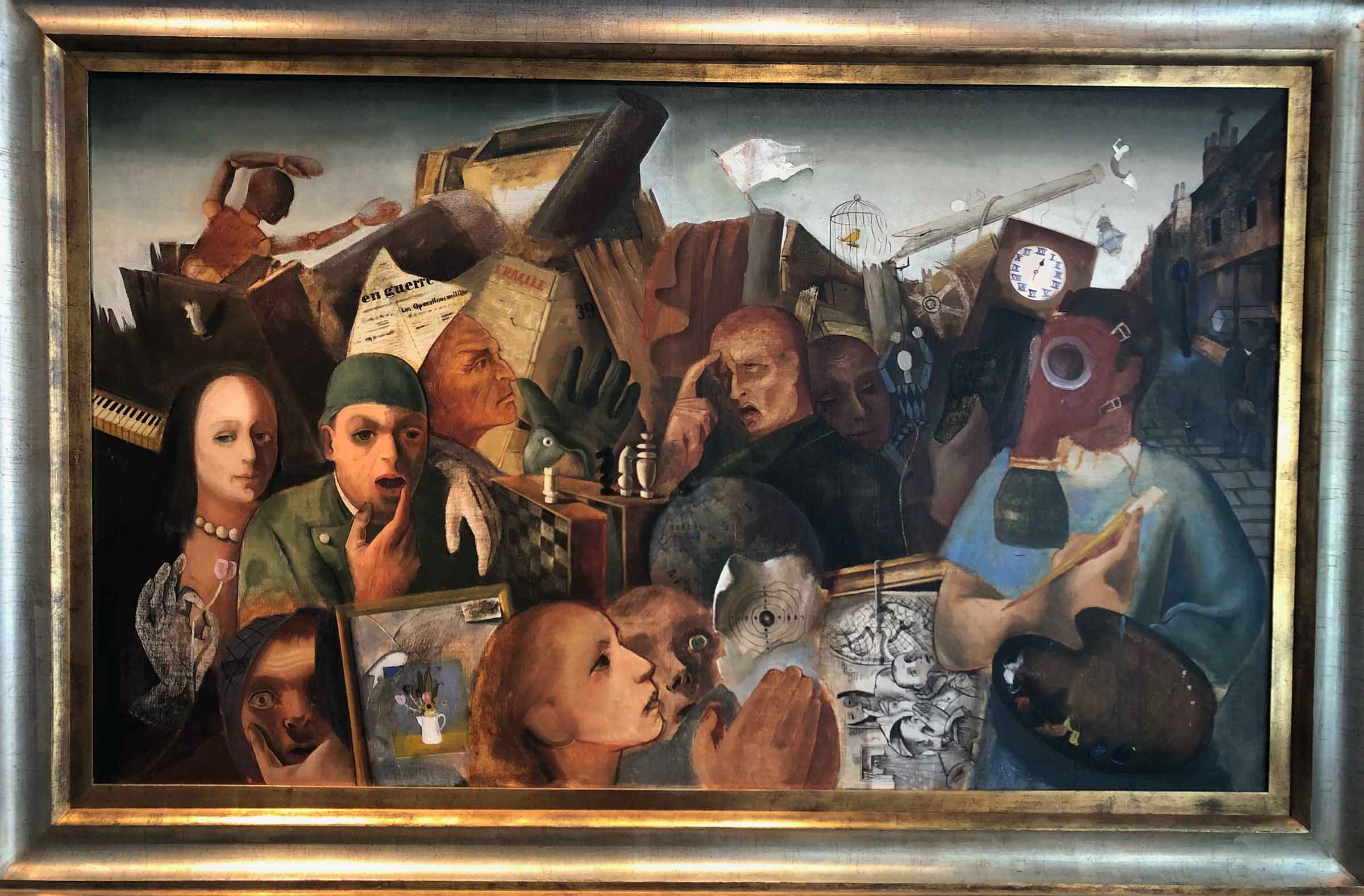
The museum also features the largest collection of Jewish art in Belgium, much of it from the 20th Century. There is a requisite exhibit detailing the atrocities of the Holocaust in which 25,000 of Belgium’s 70,000 Jews were murdered by the Nazis. There was an interesting photography exhibit highlighting present-day pockets of the diaspora in Asia, Africa and the Middle East, where large Jewish populations don’t exist. Still, they have managed to crave out their niche in this world in the unlikeliest of places.
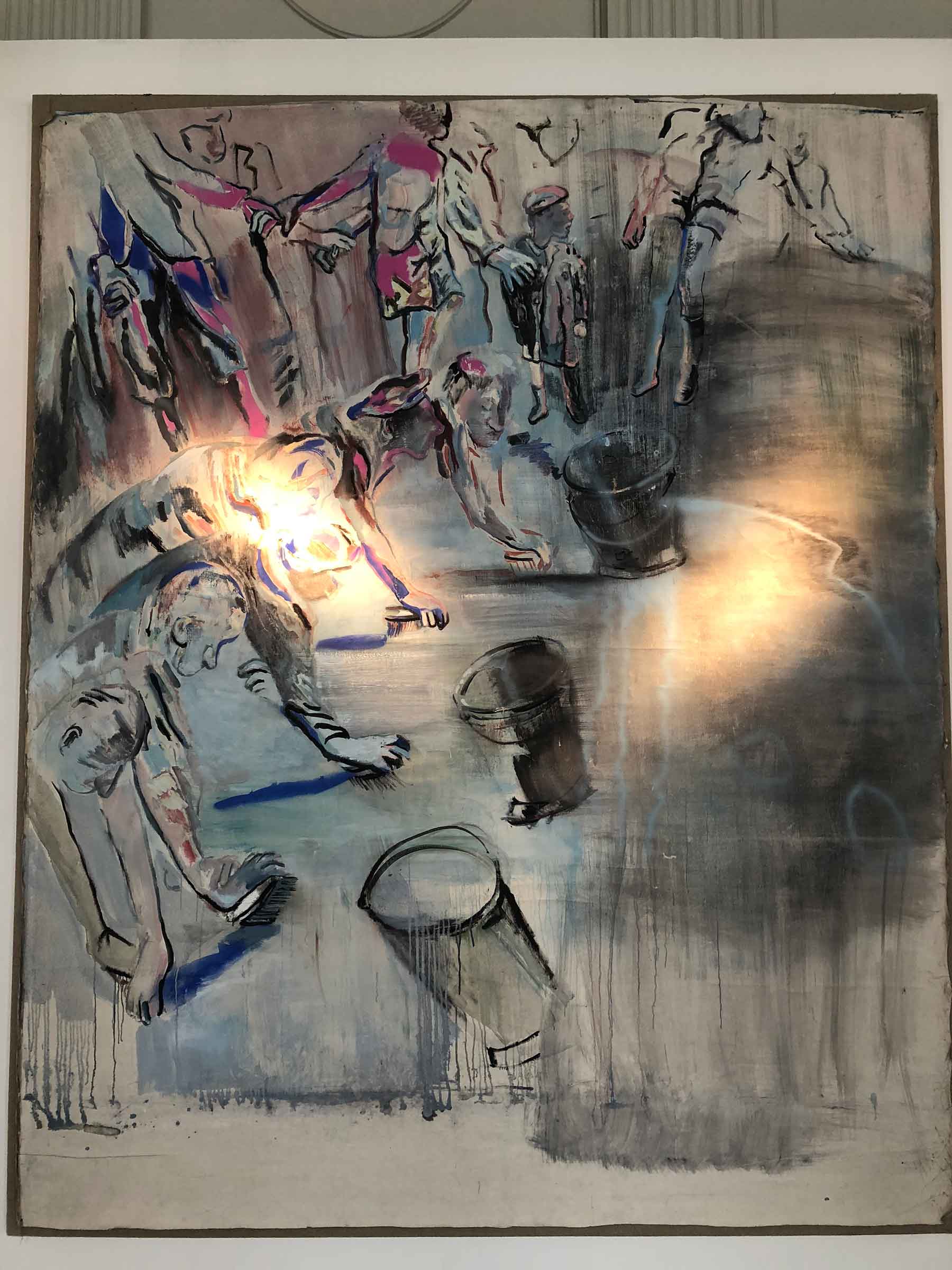
The real treat for me was seeing a special exhibition of Leonard Freed’s photography. Freed was born in Brooklyn, New York to Jewish immigrants from Eastern Europe in 1929. He developed a passion for photography and specialized in capturing the everyday life of minorities, racial discrimination, law enforcement and revolutions all over the globe. He marched with Martin Luther King Jr and released “Black in White America,” in 1968, earning him acclaim. He later gained the trust of the NYPD and was allowed to ride with cops and take photos of crime scenes between 1972-79, leading to another anthology entitled “Police Work.” It was incredible seeing the images of Harlem and Greenwich Village during the Civil Rights and Gay Liberation movements in the 1950s-70s. Freed captured images of conflicts in Palestine and Israel, the Cold War in East Germany and the Romanian Revolution in 1989. Rather than focus on the major players and events in these movements, Freed put the spotlight on everyday people, illuminating their joys and sorrows. It was all extremely moving and enlightening.
Unfortunately, like the synagogue, the Jewish Museum was the site of a terror attack in 2014, when a gunmen shot and killed four people inside the museum. You must bring and surrender your passport to gain entry, as well as pass through a metal detector and screening.
Église Notre-Dame de la Chapelle/Onze-Lieve-Vrouw-ter-Kapellekerk (Chapel Church)
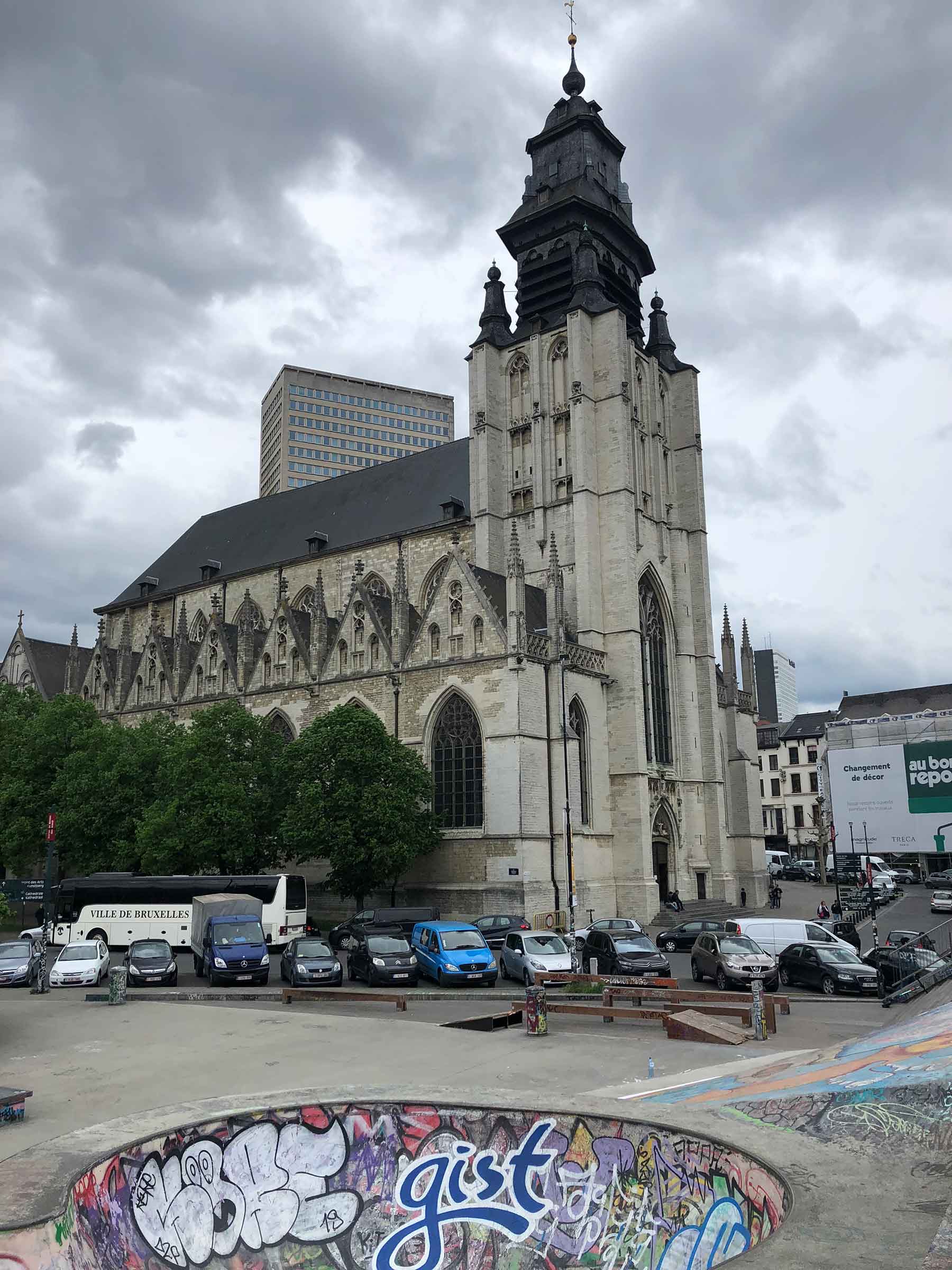
Back to our regularly-scheduled programming, the Chapel Church is one of the oldest in Brussels, dating back over 800 years to 1210. It was built in a blended Romanesque-Gothic style; Romanesque evolved into Gothic, which in turn gave way to the Renaissance style, which we will be exploring shortly. Many of the windows have the pointed Gothic arch, but some of the smaller window style hold true to the semi-circular Romanesque ideal. The black upper tier of the church is like a Romanesque topper placed on a Gothic birthday cake, giving the church a distinct look.
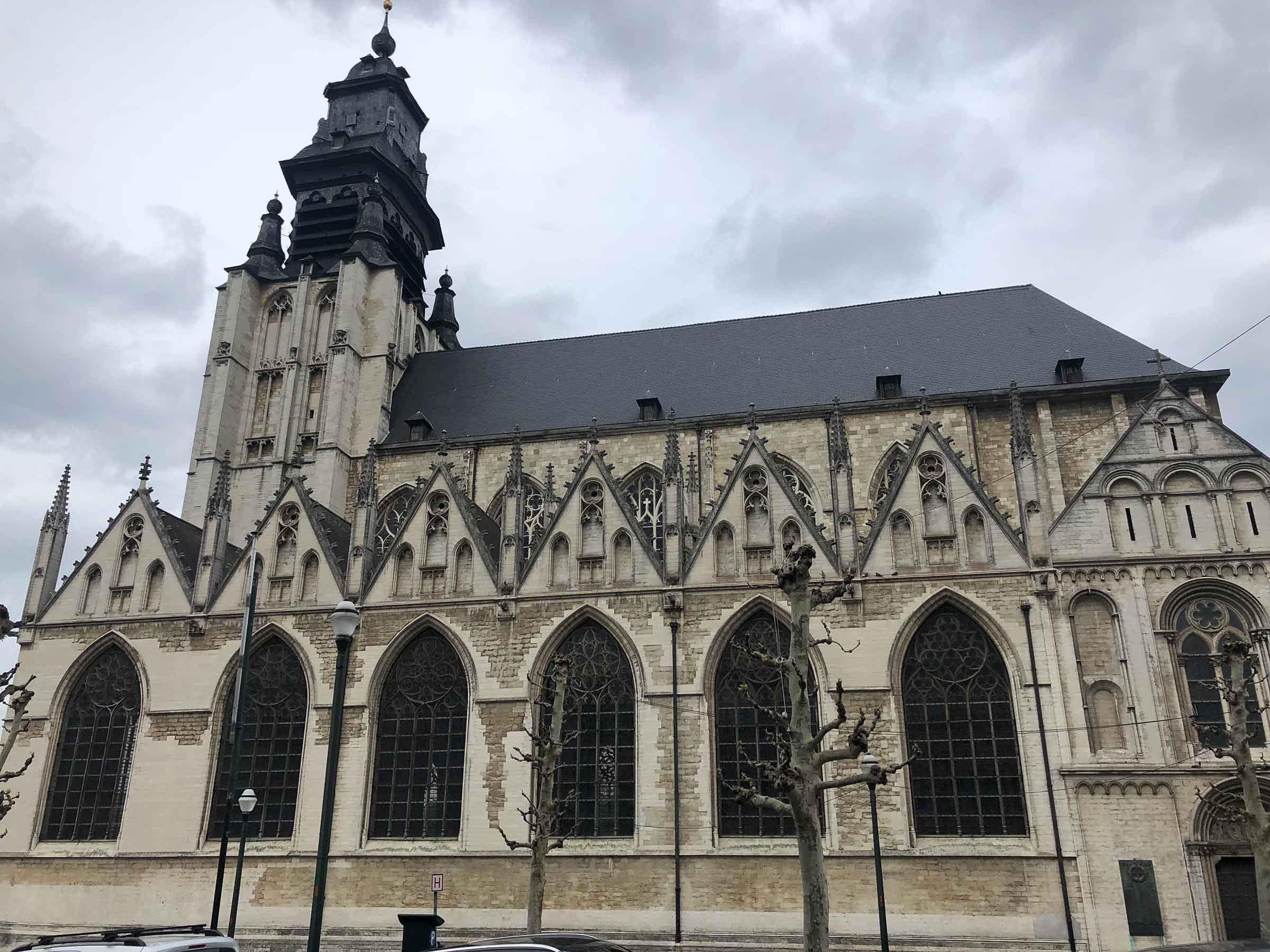
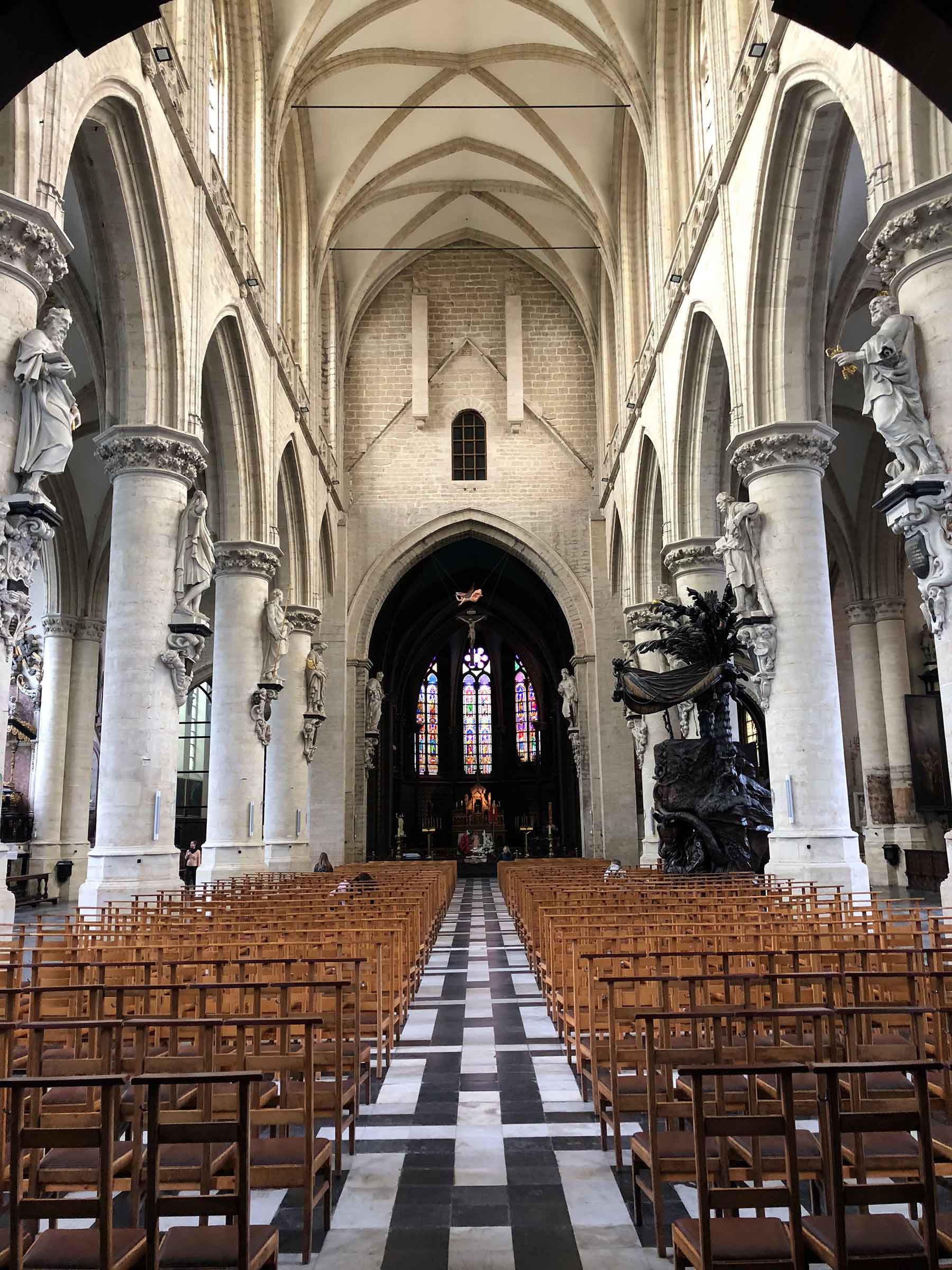
Inside the Chapel Church you will find more pointed arches and the classic Gothic rib-vaulted ceiling. Built more in the French Gothic style than the Brabantine Gothic common in the Low Countries, the Chapel Church is constructed from imported limestone rather than local sandstone. If the Chapel Church is the only church you visit in Brussels, then this detail about the limestone might feel superfluous, but taken in context with the other Gothic churches in the city, it holds greater meaning. Like any science experiment, the greater the sample size, the increased chances you will discover meaningful trends and tendencies.
Place du Petit Sablon/Kleine Zavel
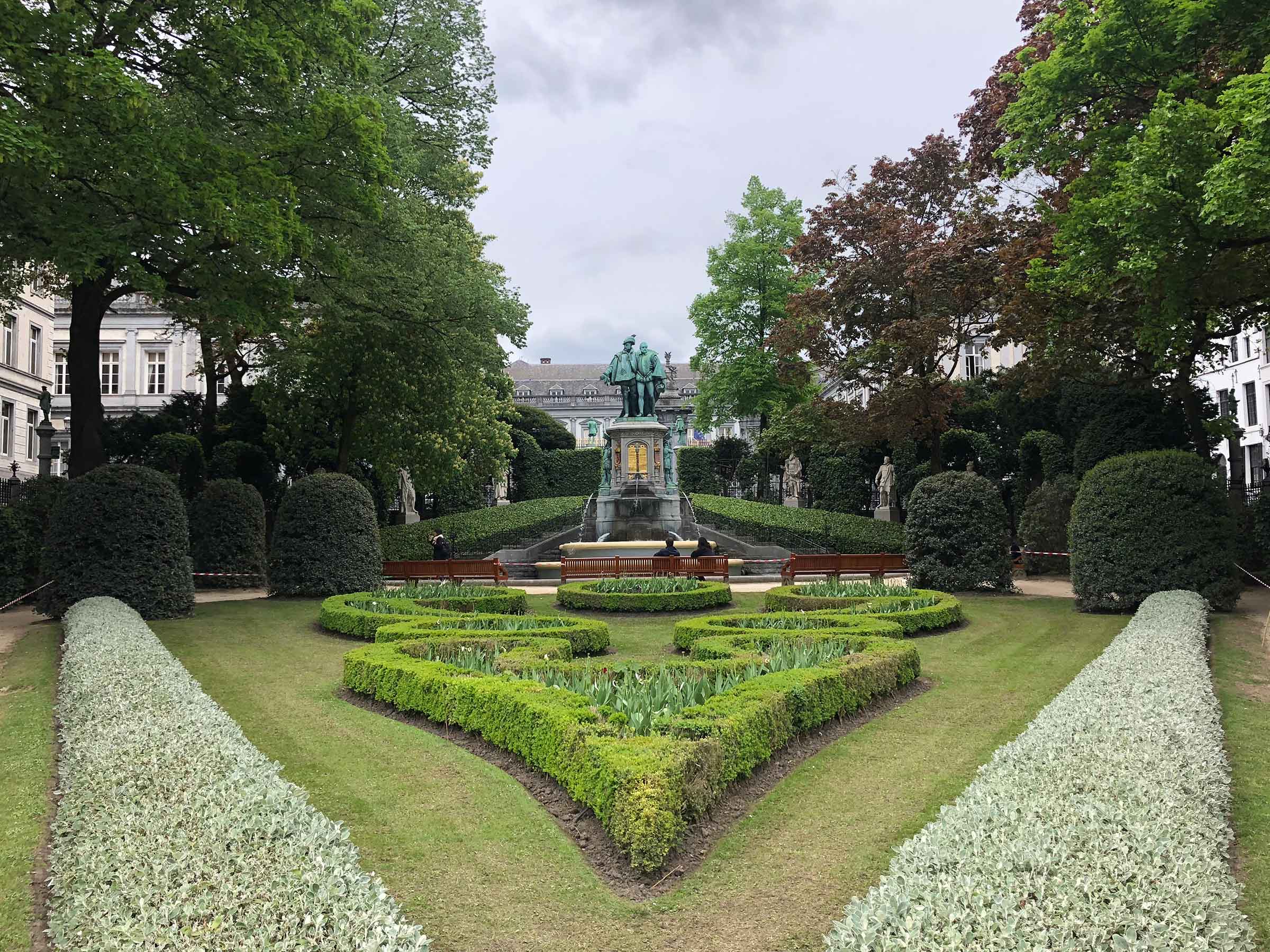
Sablon is one of the wealthiest districts in all of Brussels. Here you’ll find designer boutiques and high-end chocolate shops. Once the site of a horse market, this park was built in 1890 in the Neo-Renaissance style. This landscaping aesthetic emerged from Italy in the 19th Century and focuses on the symmetry and harmony between man and nature. Whereas French Formal Gardens show man asserting his dominance over nature, here we are one with the garden. Instead of looking down on the garden from a raised platform, the highest elevation is given to the water feature.
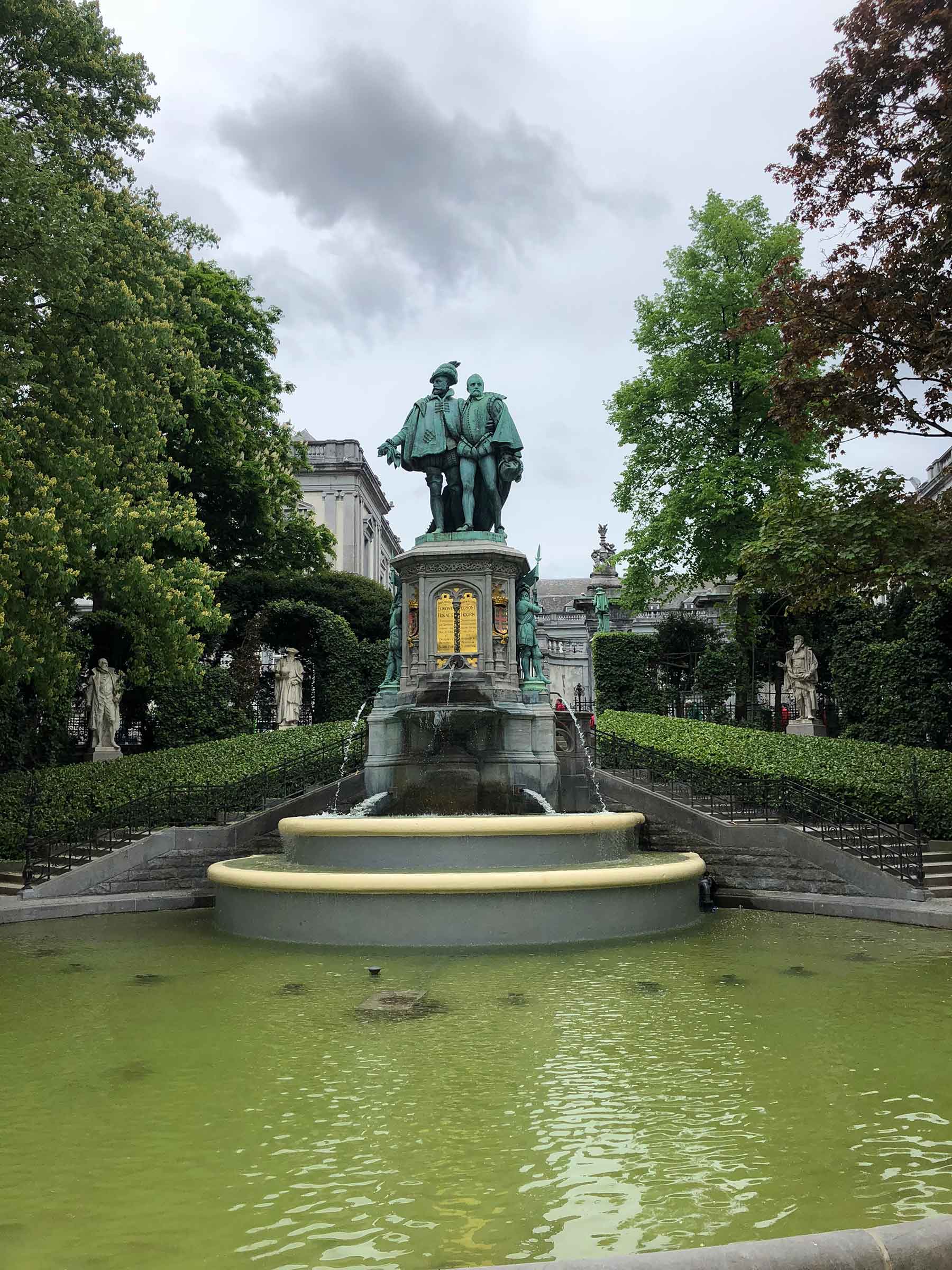
The statues around the park are not those of saints or religious figures, but rather of mapmakers, poets and other Belgian scholars befitting of the Renaissance theme. There are 48 statues atop the outer fence of the garden that represent the 48 different guilds of medieval Brussels. Memorizing the placement of each and every guild isn’t what’s important here. The takeaway is that the Neo-Renaissance style not only has stylistic characteristics, but also leans into the nostalgia for a time when artisans, craftsmen, scholars and artists were elevated in society.
Église Notre-Dame du Sablon/Onze-Lieve-Vrouw-ter-Zavelkerk (Our Lady of Sablon)
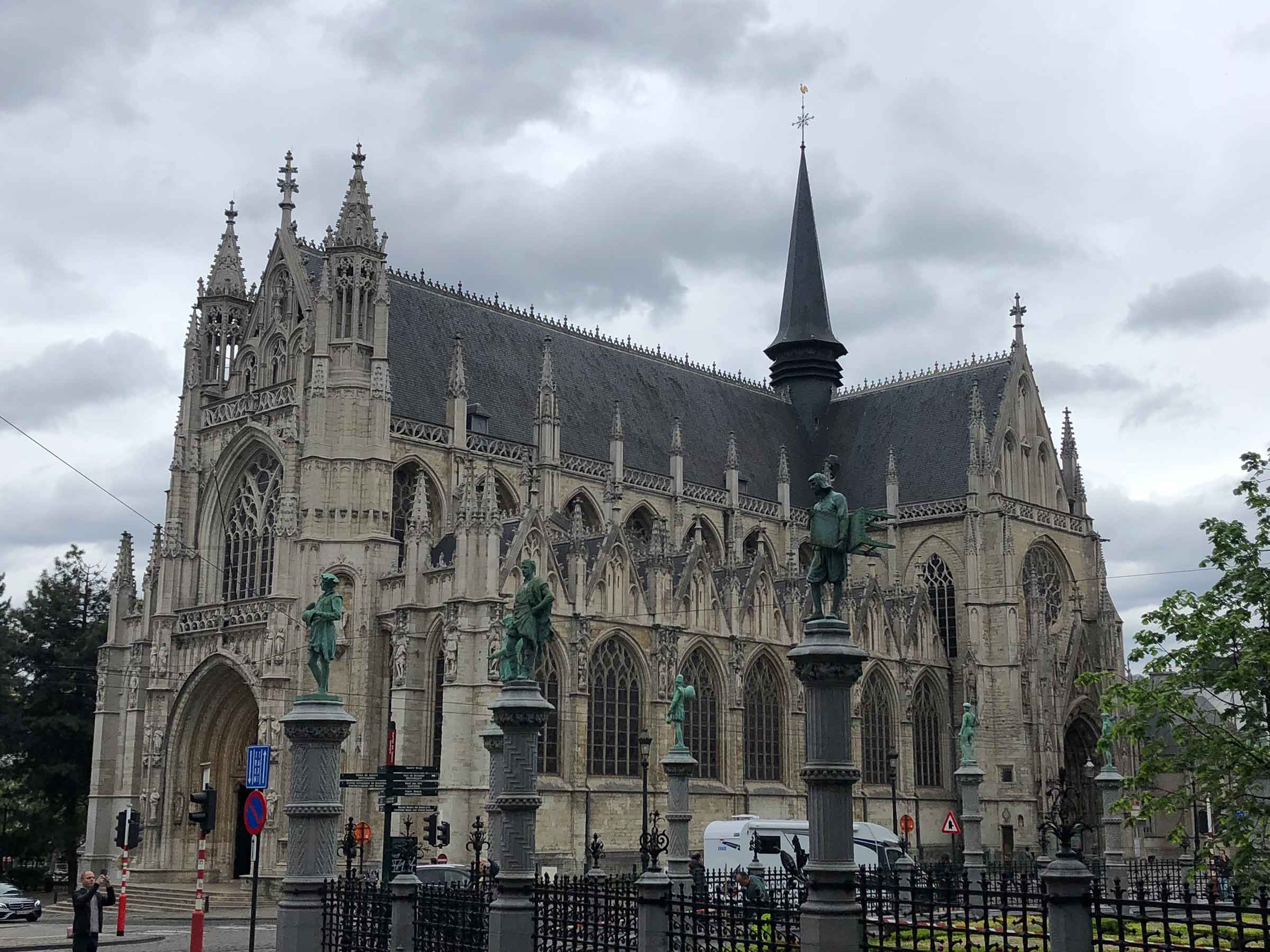
Across the street from the Place du Petit Sablon (notice the statues of the guild members in the foreground) is Our Lady of Sablon, an example of Eclecticism by force rather than design. The exterior of the church was built by a union of crossbowmen over the course of a century from 1400-1500. The exterior is (mostly) a prime example of the Brabantine Gothic style, but the inside is anything but. In the 1700s, the church fell on hard times and was purchased by a wealthy Belgian family. The new owners hired architects to build chapels, window features, floors and ceilings from all different styles. Several designers pushed back against this Eclecticism (which hadn’t even been established as an “official” movement yet; I guess this family was its first pioneer!), but money talks and the architects did what they were told. This church is nice to visit near the end of your explorations, as you’ll be able to spot all the various styles that you picked up along the way.
Le Cinquantenaire/Jubelpark
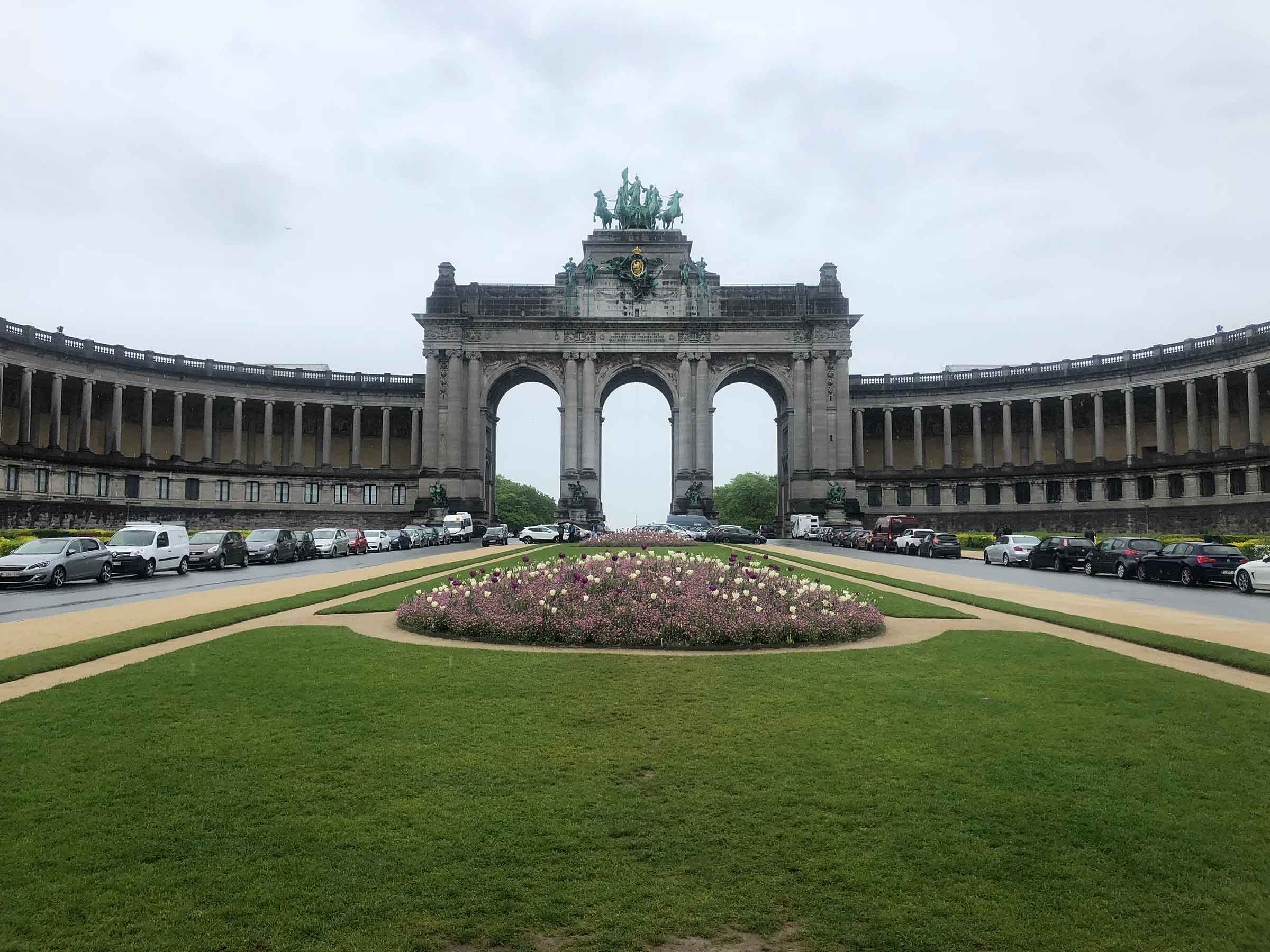
Though King Leopold II is nicknamed “The Great Builder,” he really should be called “The Great Demolisher.” He had big ideas and was always ready to raze a neighborhood, but rarely did his projects experience much of a follow-through. Le Cinquantenaire is no exception.
Planned to commemorate Belgium’s Golden Jubilee of independence in 1880, Le Cinquantenaire was meant to contain an exposition center, triumphant arch and Neoclassical garden. By the time the Golden Jubilee celebration rolled around, only the bases for the pillars of the arch had been poured and a temporary tent had to be set up in the field to hold the festivities.
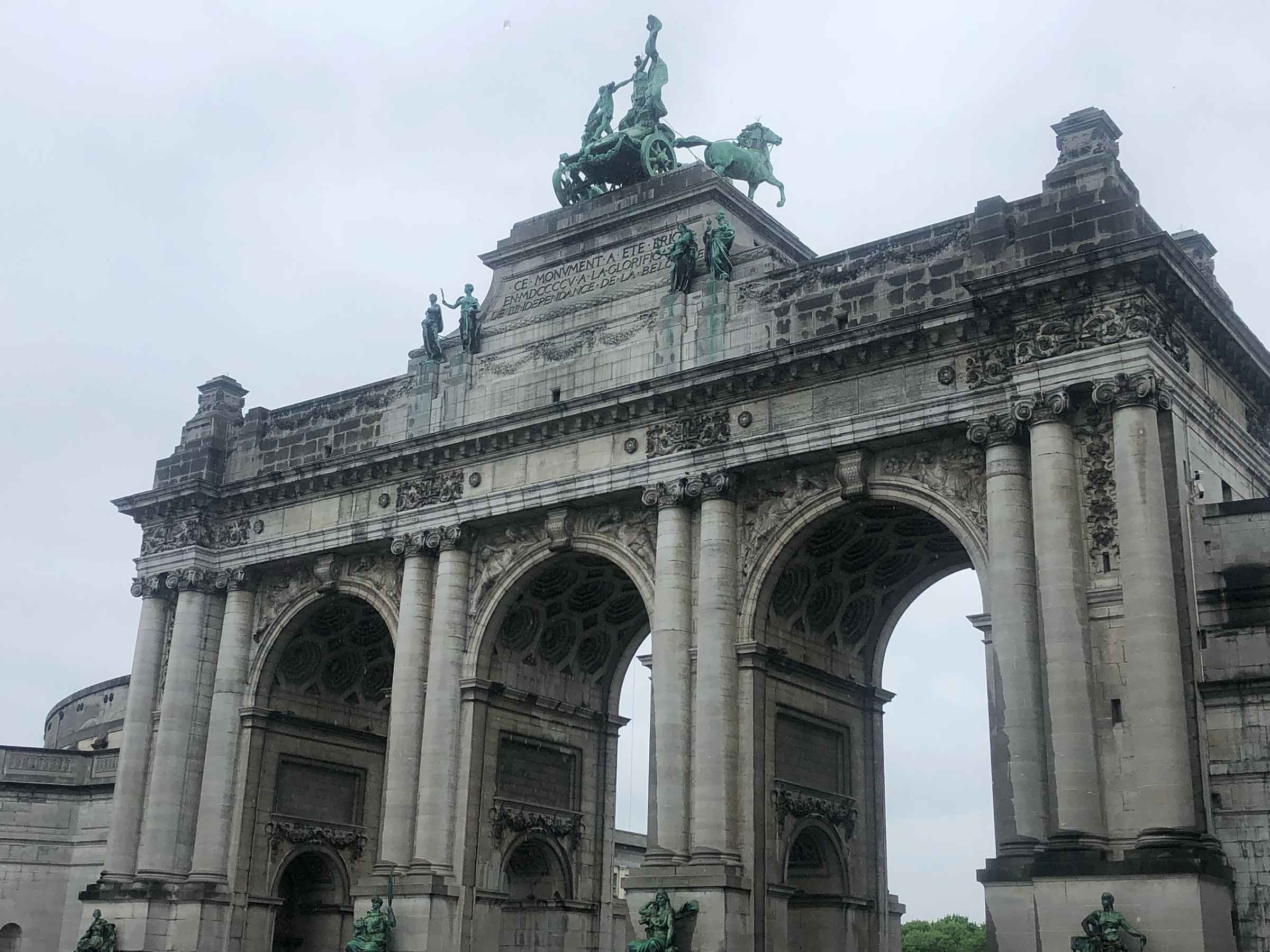
The arch wasn’t actually completed until 1905, just in time for the 75th Anniversary of independence. The Greek Rival architecture was fueled by the Anti-Romanticism movement that was bucking against the Gothic Revival churches and buildings popping up elsewhere in Brussels. It’s easy for us to laugh or shrug our shoulders at these rivalries today, but these were real artists waging aesthetic and philosophical war with one another in their city. These structures symbolized something bigger and more important to them than their primary functions. They represented national identity and the spirit of the people, not just for Belgian citizens, but as a statement to the whole world. Here you see strong lines, stoic figures and patriotic symbols. The arch projects an image of a mighty and powerful Belgium, one that has yet to be tested by the coming World Wars.
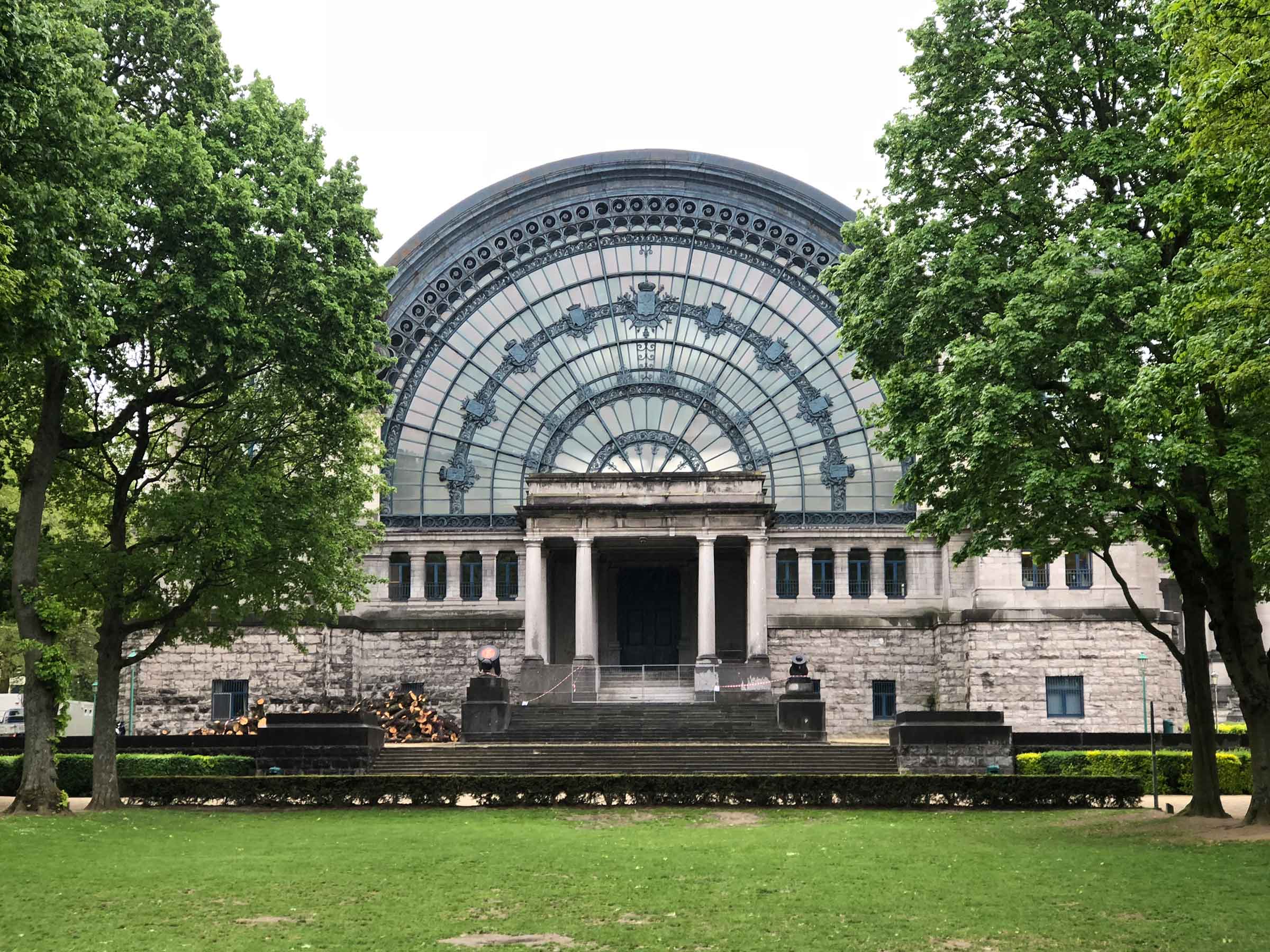
Today, the finished Cinquantenaire complex houses three museums dedicated to three subjects I easily found skippable: cars, military weapons and applied arts. Still, the Art Deco exteriors are gorgeous and worth a peek. The park was completely devoid of tourists when I visited in the middle of the afternoon and I happily took the time to journal at one of the many park benches. This is the place to come if you need some respite from the hectic city.
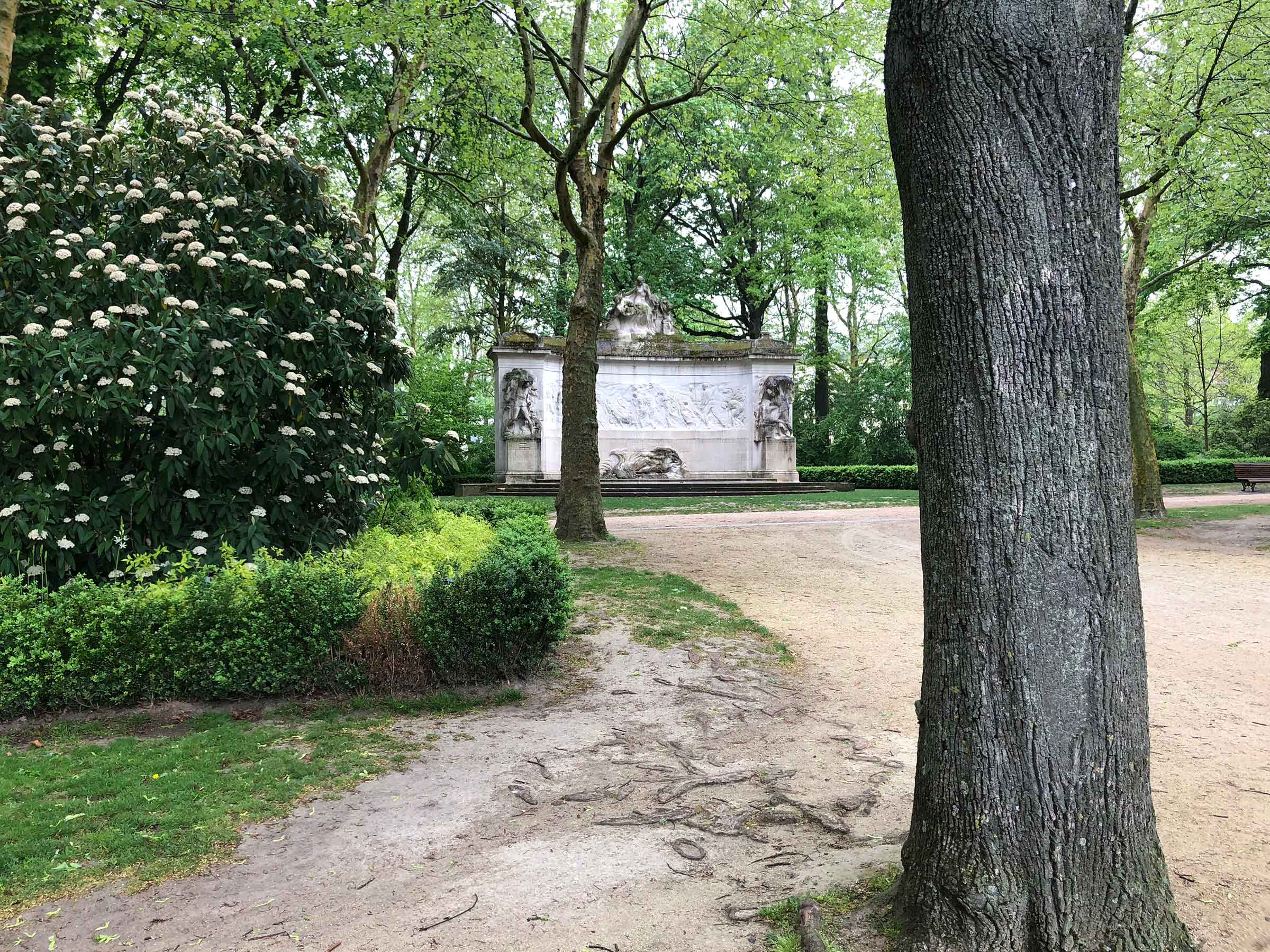
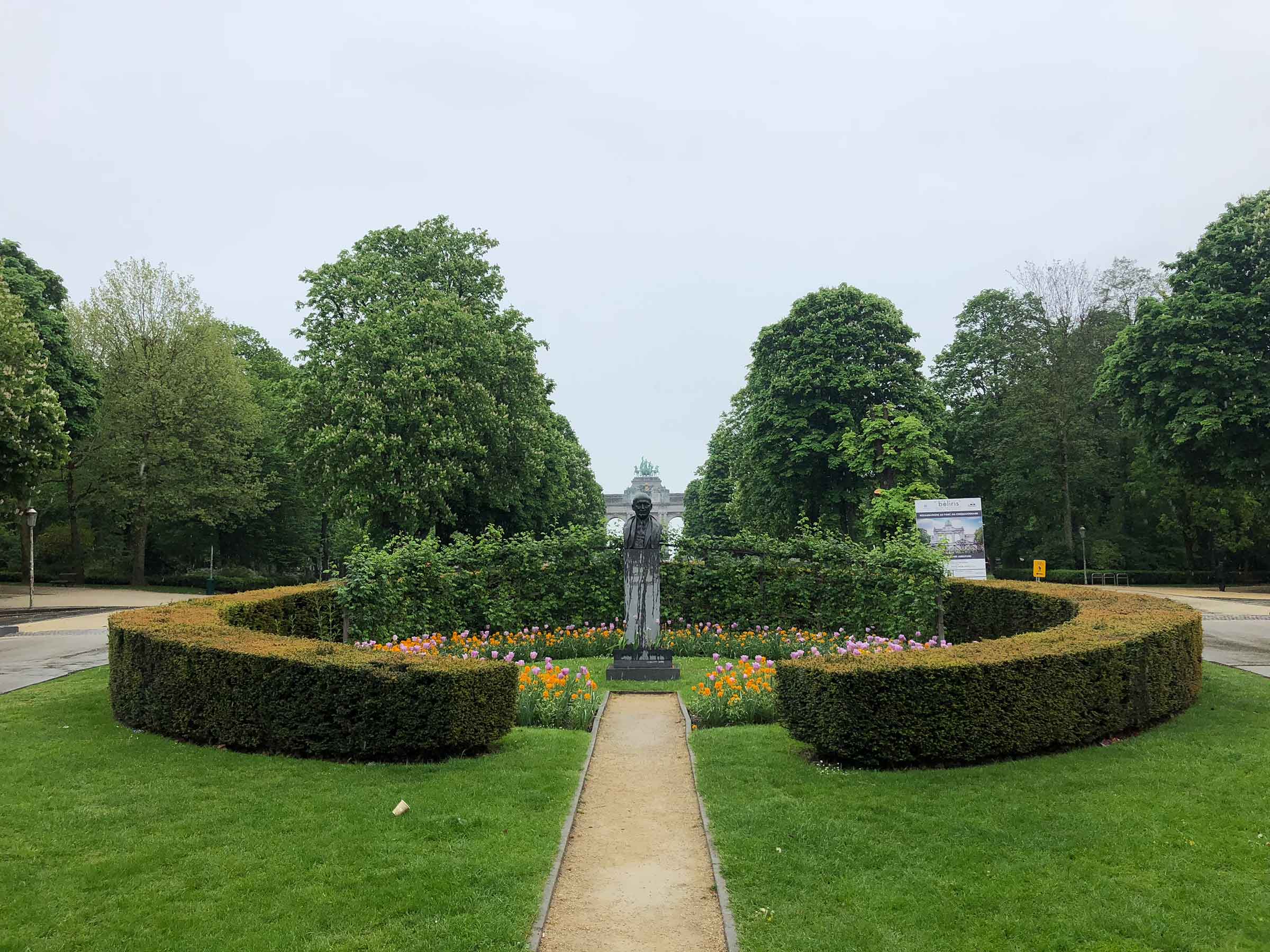
Old England Department Store
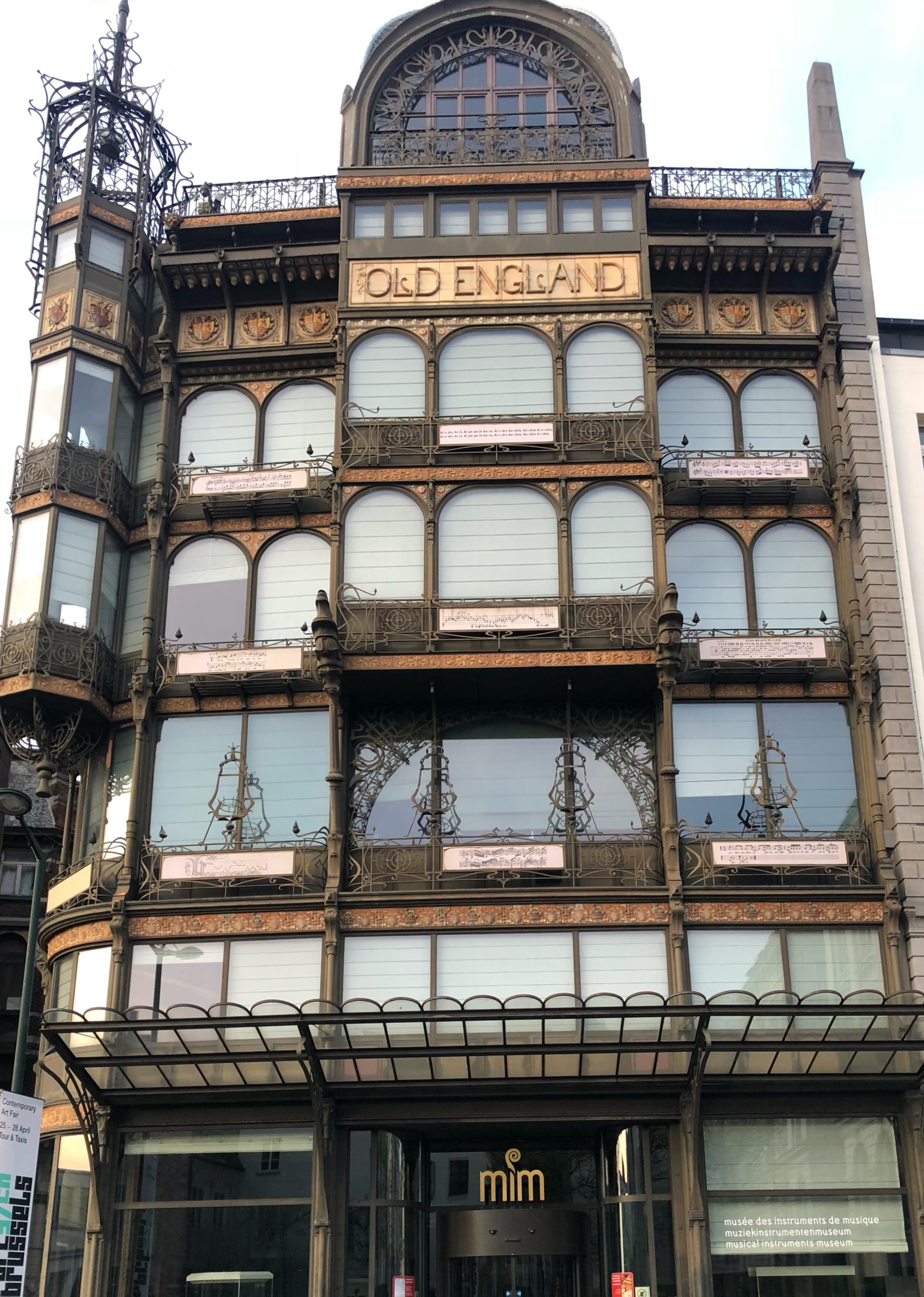
We’re nearing the end of our architectural journey here, but I would be remiss if I didn’t mention the importance of Art Nouveau in turn-of-the-century Brussels. Championed by Leopold II and conceived by the brilliant Victor Horta, Art Nouveau is characterized by floral and animal patterns, arabesques and a devotion to the female form. The Old English Department Store (now the Musical Instruments Museum) was designed by one of Horta’s contemporaries, Paul Saintenoy in 1898 and typifies the florid Art Nouveau style.
Leopold took an instant liking to Art Nouveau and began giving citizens something akin to a tax credit if they would build or remodel their homes in this en-vogue aesthetic. Suddenly, hundreds of Art Nouveau residences began springing up all over Brussels, several of which have been declared UNESCO protected sites since. Many of Horta’s most famous buildings are located in the municipality of Ixelles, just south of Brussels, but if you don’t want to leave the city center, take a stroll down Rue du Midi and you’ll have plenty to feast your eyes on.
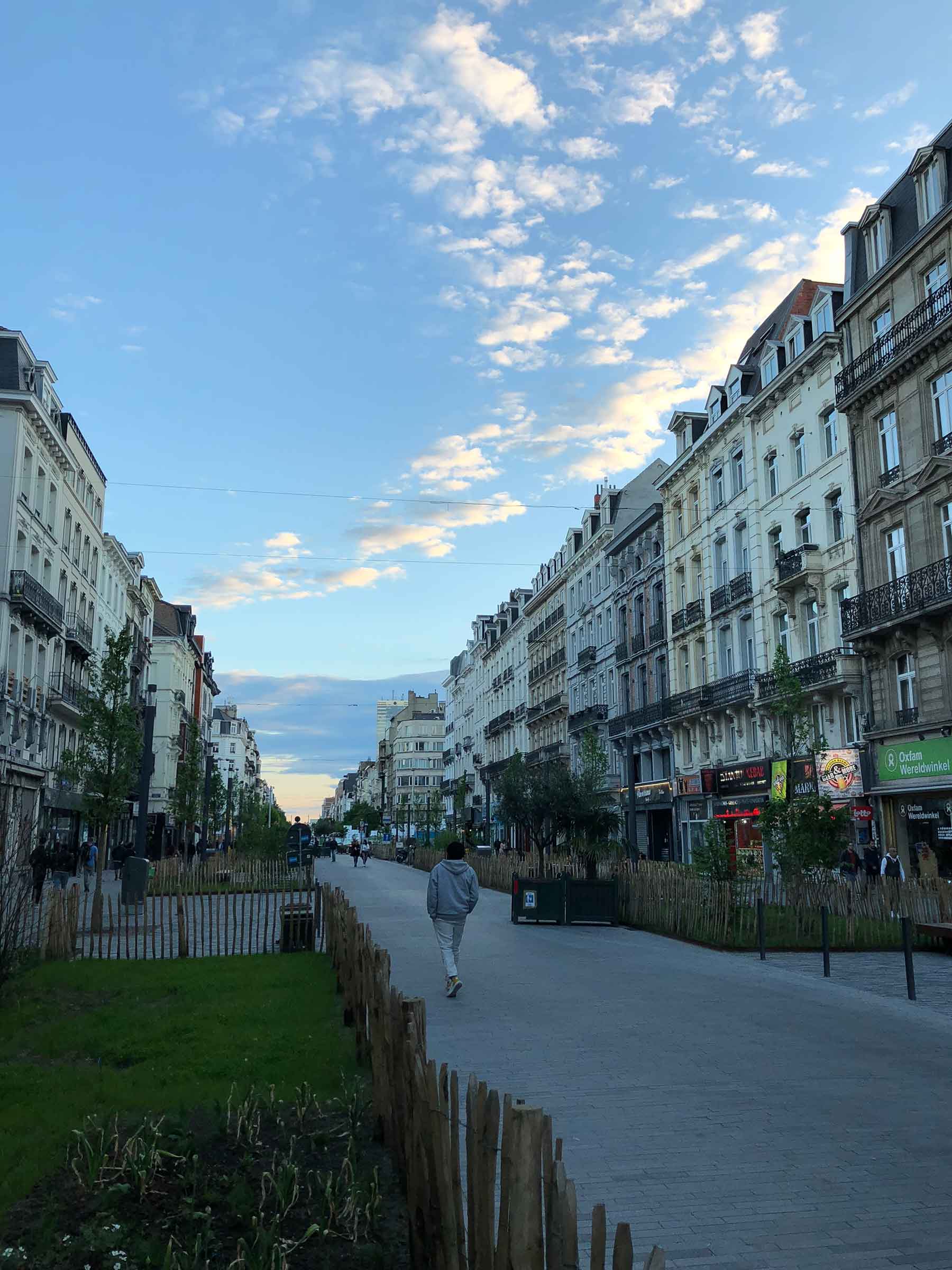
Now I’ll let you be the judge. Did this detail-orientated approach to exploration overwhelm you, or did all the bits and pieces come together and enhance your overall knowledge of architecture and urban planning? Before Brussels, I had little to no confidence identifying different architectural styles that didn’t start with socialist and end with brutalism. With a little conscious effort, I somehow managed to take a few great strides forward. My aim isn’t to become an expert or a know-it-all, but to better understand and appreciate the buildings I have yet to encounter.
To return to the movie quote at the top of this post, the hilarious James Coco, spoofing a version of Hercule Poirot in Neil Simon’s Murder By Death, can’t handle being referred to a “Frenchie” anymore, when he is in fact a “Belgie.” The accent and mannerisms might be similar enough to the other characters, but this detail speaks to the Coco’s character’s entire identity. “If you’ve seen once church, you’ve seen them all,” only holds true if you only have the tools to view each church in a superficial way. Dig deeper, discover their true identities and you might find that second or third church on the list has something more to offer than previously imagined.
